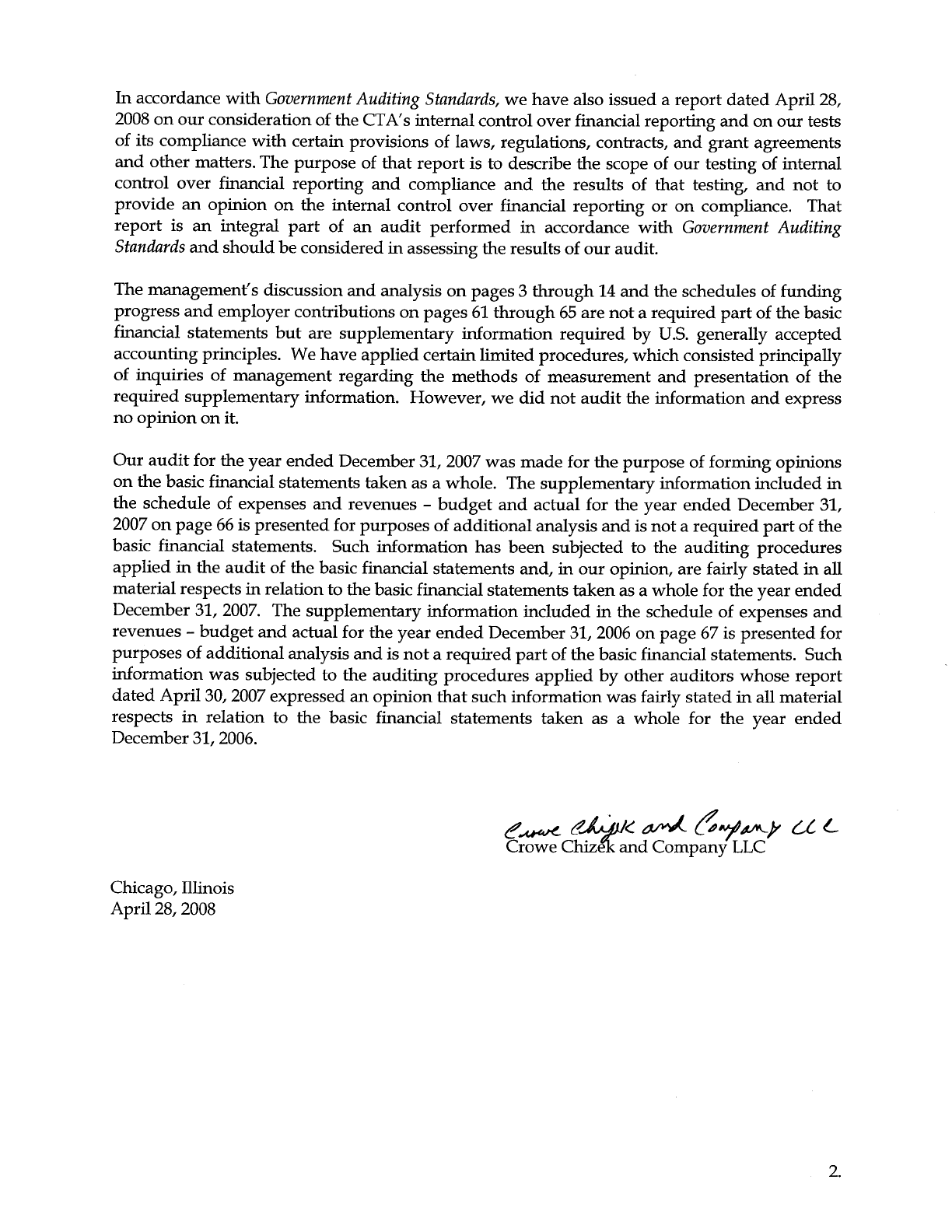CHICAGO TRANSIT AUTHORITY
FINANCIAL STATEMENTS AND
SUPPLEMENTARY INFORMATION
December 31, 2007 and 2006
(With Independent Auditors’ Report Thereon)
CHICAGO TRANSIT AUTHORITY
Chicago, Illinois
FINANCIAL STATEMENTS
December 31, 2007 and 2006
CONTENTS
Independent Auditors’ Report............................................................................................................. 1
Management’s Discussion and Analysis ............................................................................................ 3
Basic Financial Statements
Balance Sheets .................................................................................................................................. 15
Statements of Revenues, Expenses, and Changes in Net Assets .............................................. 17
Statements of Cash Flows............................................................................................................... 18
Statements of Fiduciary Net Assets .............................................................................................. 20
Statements of Changes in Fiduciary Net Assets.......................................................................... 21
Notes to Financial Statements........................................................................................................ 22
Required Supplementary Information
Schedules of Funding Progress ..................................................................................................... 61
Schedules of Employer Contributions – Employees’ Plan ........................................................ 63
Schedules of Employer Contributions – Supplemental Plans................................................... 65
Supplementary Schedules
Schedule of Expenses and Revenues – Budget and Actual –
Budgetary Basis – 2007.................................................................................................................. 66
Schedule of Expenses and Revenues – Budget and Actual –
Budgetary Basis – 2006.................................................................................................................. 67

Crowe Chizek and Company LLC
Member Horwath International
1.
Independent Auditors’ Report
Chicago Transit Board
Chicago Transit Authority
Chicago, Illinois
We have audited the accompanying financial statements of the business-type and fiduciary
activities of the Chicago Transit Authority (CTA) as of and for the year ended December 31,
2007, which collectively comprise the CTA’s basic financial statements, as listed in the table of
contents. These financial statements are the responsibility of the CTA’s management. Our
responsibility is to express opinions on these financial statements based on our audit. The
financial statements of the CTA as of December 31, 2006, were audited by other auditors whose
report dated April 30, 2007, expressed an unqualified opinion on those statements.
We conducted our audit in accordance with auditing standards generally accepted in the
United States of America and the standards applicable to financial audits contained in
Government Auditing Standards, issued by the Comptroller General of the United States. Those
standards require that we plan and perform the audit to obtain reasonable assurance about
whether the financial statements are free of material misstatement. An audit includes
consideration of internal control over financial reporting as a basis for designing audit
procedures that are appropriate in the circumstances, but not for the purpose of expressing an
opinion on the effectiveness of the CTA’s internal control over financial reporting. Accordingly,
we express no such opinion. An audit also includes examining, on a test basis, evidence
supporting the amounts and disclosures in the financial statements, assessing the accounting
principles used and significant estimates made by management, as well as evaluating the
overall financial statement presentation. We believe that our audit provide a reasonable basis
for our opinions.
In our opinion, the basic financial statements referred to above present fairly, in all material
respects, the financial position of the business-type and fiduciary activities of the CTA as of
December 31, 2007, and the respective changes in financial position and, where applicable, cash
flows thereof for the years then ended, in conformity with U.S. generally accepted accounting
principles.


CHICAGO TRANSIT AUTHORITY
MANAGEMENT’S DISCUSSION AND ANALYSIS
December 31, 2007 and 2006
(Continued)
3.
Introduction
The following discussion and analysis of the financial performance and activity of the Chicago
Transit Authority (CTA) provide an introduction and understanding of the basic financial
statements of the CTA for the fiscal years ended December 31, 2007 and 2006. This discussion
was prepared by management and should be read in conjunction with the financial statements
and the notes thereto, which follow this section.
Financial Highlights for 2007
• Net assets totaled $1,412,258,000 at December 31, 2007.
• Net assets decreased $331,265,000 in 2007, which compares to a decrease of $103,559,000 in
2006.
• Total net capital assets were $3,445,706,000 at December 31, 2007, an increase of 7.61% over
the balance at December 31, 2006 of $3,202,171,000.
Financial Highlights for 2006
• Net assets totaled $1,743,523,000 at December 31, 2006.
• Net assets decreased $103,559,000 in 2006, which compares to a decrease of $153,572,000 in
2005.
• Total net capital assets were $3,202,171,000 at December 31, 2006, an increase of 7.54% over
the balance at December 31, 2005 of $2,977,603,000.
The Financial Statements
The basic financial statements provide information about the CTA’s business-type activities and
the Open Supplemental Retirement Fund (fiduciary activities). The financial statements are
prepared in accordance with U.S. generally accepted accounting principles as promulgated by
the Governmental Accounting Standards Board (GASB).
Overview of the Financial Statements for Business-Type Activities
The financial statements consist of the (1) balance sheet, (2) statement of revenues, expenses,
and changes in net assets, (3) statement of cash flows, and (4) notes to the financial statements.
The financial statements are prepared on the accrual basis of accounting, meaning that all
expenses are recorded when incurred and all revenues are recognized when earned, in
accordance with U.S. generally accepted accounting principles.

CHICAGO TRANSIT AUTHORITY
MANAGEMENT’S DISCUSSION AND ANALYSIS
December 31, 2007 and 2006
(Continued)
4.
Balance Sheet
The balance sheet reports all financial and capital resources for the CTA (excluding fiduciary
activities). The statement is presented in the format where assets equal liabilities plus net assets,
formerly known as equity. Assets and liabilities are presented in order of liquidity and are
classified as current (convertible into cash within one year) and noncurrent. The focus of the
balance sheet is to show a picture of the liquidity and health of the organization as of the end of
the year.
The balance sheet (the unrestricted net assets) is designed to present the net available liquid
(noncapital) assets, net of liabilities, for the entire CTA. Net assets are reported in three
categories:
• Net Assets Invested in Capital Assets, Net of Related Debt—This component of net assets
consists of all capital assets, reduced by the outstanding balances of any bonds, notes, or other
borrowings that are attributable to the acquisition, construction, or improvement of those assets.
• Restricted Net Assets—This component of net assets consists of restricted assets where
constraints are placed upon the assets by creditors (such as debt covenants), grantors,
contributors, laws, and regulations, etc.
• Unrestricted Net Assets—This component consists of net assets that do not meet the definition
of net assets invested in capital assets, net of related debt, or restricted net assets.
Statement of Revenues, Expenses, and Changes in Net Assets
The statement of revenues, expenses, and changes in net assets includes operating revenues,
such as bus and rail passenger fares, rental fees received from concessionaires, and the fees
collected from advertisements on CTA property; operating expenses, such as costs of operating
the mass transit system, administrative expenses, and depreciation on capital assets; and
nonoperating revenue and expenses, such as grant revenue, investment income, and interest
expense. The focus of the statement of revenues, expenses, and changes in net assets is the
change in net assets. This is similar to net income or loss and portrays the results of operations
of the organization for the entire operating period.
Statement of Cash Flows
The statement of cash flows discloses net cash provided by or used for operating activities,
investing activities, noncapital financing activities, and from capital and related financing
activities. This statement also portrays the health of the CTA in that current cash flows are
sufficient to pay current liabilities.

CHICAGO TRANSIT AUTHORITY
MANAGEMENT’S DISCUSSION AND ANALYSIS
December 31, 2007 and 2006
(Continued)
5.
Notes to Financial Statements
The notes to financial statements are an integral part of the basic financial statements and
describe the significant accounting policies, related-party transactions, deposits and
investments, capital assets, capital lease obligations, bonds payable, long-term liabilities,
defined-benefit pension plans, derivative financial instruments, and the commitments and
contingencies. The reader is encouraged to review the notes in conjunction with the
management discussion and analysis and the financial statements.
Financial Analysis of the CTA’s Business-Type Activities
Balance Sheet
The following table reflects a condensed summary of assets, liabilities, and net assets of the CTA
as of December 31, 2007, 2006, and 2005:
T
a
bl
e
1
Summary of Assets, Liabilities, and Net Assets
December 31, 2007, 2006, and 2005
(In thousands of dollars)
2007 2006 2005
Assets:
Current assets 496,326
$
418,591
$
407,698
$
Restricte
d
assets 1,941,364 2,190,409 2,052,990
Other assets 15,177 16,101 16,390
Capital assets, net 3,445,706 3,202,171 2,977,603
Total assets 5,898,573$ 5,827,272$ 5,454,681$
Liabilities:
Current liabilities 710,765
$
501,238
$
429,054
$
Long-term liabilities 3,775,550 3,582,511 3,178,545
Total liabilities 4,486,315 4,083,749 3,607,599
Net assets:
Invested in capital assets, net
of related debt 2,912,748
$
2,933,473
$
2,767,809
$
Restricted for payment of leasehold
o
bl
igations 37,992 33,017 24,211
Restricte
d
f
or
d
e
b
t service 32,233 31,379 32,840
Restricte
d
b
y RTA
f
or operations an
d
capita
l
improvements 5,430 5,818 7,460
Unrestricted (unrestricted) (1,576,145) (1,260,164) (985,238)
Total net assets 1,412,258 1,743,523 1,847,082
Total liabilities and net assets 5,898,573$ 5,827,272$ 5,454,681$

CHICAGO TRANSIT AUTHORITY
MANAGEMENT’S DISCUSSION AND ANALYSIS
December 31, 2007 and 2006
(Continued)
6.
Year Ended December 31, 2007
Current assets increased by 18.57% to $496,326,000. The change in current assets is primarily
due to the increase in cash and investments.
Restricted assets decreased by 11.37% to $1,941,364,000 due to the utilization of bond proceeds
during 2007.
Other assets decreased by 5.74% to $15,177,000 primarily due to the amortization of bond issue
costs and decrease in net pension asset.
Capital assets (net) increased by 7.61% to $3,445,706,000 due to the CTA’s capital improvement
projects. The CTA’s capital improvement projects were funded primarily by the Federal Transit
Administration (FTA), the Illinois Department of Transportation (IDOT), the Regional
Transportation Authority (RTA), and CTA bonds.
Current liabilities increased 41.8% to $710,765,000 primarily due to an increase in accounts
payable, advances, and the current portion of capital lease obligations.
Long-term liabilities increased 5.39% to $3,775,550,000 due primarily to an increase in net
pension obligation.
Net assets invested in capital assets, net of related debt consists of capital assets, net of
accumulated depreciation, and reduced by the amount of outstanding indebtedness attributable
to the acquisition, construction, or improvement of those assets.
The net asset balances restricted for other purposes include amounts restricted for three distinct
purposes. The first restriction is for the assets restricted for future payments on the lease
obligations. The second restriction is for the assets restricted for debt service payments. The
third restriction is for operating grants received from the RTA that are restricted for future
operations and capital improvements.
Unrestricted net assets (deficit), which represent assets available for operations, increased
25.07% over the prior year, primarily due to unfunded pension and postemployment healthcare
expense (i.e. increase in the net pension obligation) of $305,126,000.

CHICAGO TRANSIT AUTHORITY
MANAGEMENT’S DISCUSSION AND ANALYSIS
December 31, 2007 and 2006
(Continued)
7.
Year Ended December 31, 2006
Current assets increased by 2.67% to $418,591,000. The change in current assets is primarily due
to the increase in grants receivable which is offset by a decrease in cash, investments, and
inventory.
Restricted assets increased by 6.69% to $2,190,409,000 due to the receipt of bond proceeds that
were not yet expended at year-end. During 2006, CTA issued Capital Grant Receipts Revenue
Bonds, “2006 Project,” in the amount of $275,000,000, along with a premium of $19,652,000, in
anticipation of the receipt of grants from the federal government pursuant to a full funding
grant agreement. The bonds were issued to provide funds to finance the costs of capital
improvements to the transportation system referred to as the “2006 Project.” At December 31,
2006, approximately $291,000,000 of the proceeds from this bond were unspent.
Other assets decreased by 1.76% to $16,101,000 primarily due to the amortization of bond issue
costs and decrease in net pension asset.
Capital assets (net) increased by 7.54% to $3,202,171,000 due to the CTA’s capital improvement
projects. The CTA’s capital improvement projects were funded primarily by the Federal Transit
Administration (FTA), the Illinois Department of Transportation (IDOT), the Regional
Transportation Authority (RTA), and CTA bonds.
Current liabilities increased 16.82% to $501,238,000 primarily due to an increase in accounts
payable and accrued expenses.
Long-term liabilities increased 12.71% to $3,582,511,000 due primarily to an increase in net
pension obligation and the issuance of Capital Grant Receipts Revenue Bonds in 2006.
Net assets invested in capital assets, net of related debt consists of capital assets, net of
accumulated depreciation, and reduced by the amount of outstanding indebtedness attributable
to the acquisition, construction, or improvement of those assets. This category increased 5.99%
from the prior year primarily due to capital assets, acquisitions during the year that were
funded by capital grants of $522,040,000, offset by depreciation expense of $376,910,000.
The net asset balances restricted for other purposes include amounts restricted for three distinct
purposes. The first restriction is for the assets restricted for future payments on the lease
obligations. The second restriction is for the assets restricted for debt service payments. The
third restriction is for operating grants received from the RTA that are restricted for future
operations and capital improvements.
Unrestricted net assets (deficit), which represent assets available for operations, increased
27.90% over the prior year, primarily due to unfunded pension expense (i.e. increase in the net
pension obligation) of $241,202,000.

CHICAGO TRANSIT AUTHORITY
MANAGEMENT’S DISCUSSION AND ANALYSIS
December 31, 2007 and 2006
(Continued)
8.
Statement of Revenues, Expenses, and Changes in Net Assets
The following table reflects a condensed summary of the revenues, expenses, and changes in net
assets (in thousands) for the years ended December 31, 2007, 2006, and 2005:
T
a
bl
e
2
Condensed Summary of Revenues, Expenses, and Changes in Net Assets
Years ended December 31, 2007, 2006, and 2005
(In thousands of dollars)
2007 2006 2005
Operating revenues 493,350$ 493,023$ 448,411$
Operating expenses:
Operating expenses 1,412,842 1,344,133 1,216,217
Depreciation 387,738 376,910 360,559
Total operating expenses 1,800,580 1,721,043 1,576,776
Operating loss (1,307,230) (1,228,020) (1,128,365)
Nonoperating revenues/expenses, net 600,051 602,421 576,139
Capital contributions 375,914 522,040 398,654
Change in net assets (331,265) (103,559) (153,572)
Total net assets, beginning of year 1,743,523 1,847,082 2,000,654
Total net assets, end of year 1,412,258$ 1,743,523$ 1,847,082$
Year Ended December 31, 2007
Total operating revenues increased by $327,000, or 0.07% due to a one-time utility settlement
received in 2007. Farebox revenue decreased over the prior year by approximately $5,000,000 or
1.1% despite an increase in ridership of approximately 4.7 million rides or 1.0%. The fare
structure implemented on January 1, 2006 resulted in many riders transitioning from a per ride
fare to an unlimited pass thereby driving the average fare down from $0.934 in 2006 to $0.915 in
2007.
Total operating expenses increased $79,537,000, or 4.62%. The increase is primarily driven by
higher labor, materials, electric power, and fuel expense.
Labor expense increased due to higher healthcare, pension, and workers’ compensation
expenses. Materials expense increased $1,028,000 due to increasing commodity prices, higher
mileage and the aging life of the fleet. Electric power increased $5,873,000 due to the end of the
decade long rate freeze in Illinois. Fuel expense increased $13,711,000 due to a higher average
cost per gallon due to market driven forces. In 2007, the average fuel price increased $0.50 to

CHICAGO TRANSIT AUTHORITY
MANAGEMENT’S DISCUSSION AND ANALYSIS
December 31, 2007 and 2006
(Continued)
9.
$2.82 per gallon. Other expense increased due to higher utilities, rent and facilities
maintenances costs. The provision for injuries and damages decreased by $10,000,000 due to
cost containment initiatives implemented by the CTA such as surveillance cameras and
aggressive case management practices.
At the direction of the Illinois General Assembly, on July 1, 2006, the responsibility for
providing paratransit service in the region was transitioned to Pace Suburban Bus. As a result,
there is no paratransit expense for 2007.
Year Ended December 31, 2006
Operating revenues increased by $44,612,000, or 9.95%. The revenue increase is primarily due
to higher ridership and a higher average fare. The higher average fare is due to the new fare
structure which eliminated cash transfers and increased cash and rail transit card fares.
Additionally, systemwide ridership increased by 0.5% in 2006.
Total operating expenses increased $144,267,000, or 9.15%. The increase is primarily driven by
higher labor, materials, and fuel expense.
Labor expense increased due to higher wages, pension, and workers’ compensation expenses.
Materials expense increased $11,784,000 due to increasing commodity prices, higher mileage
and the aging life of the fleet. Fuel expense increased $11,682,000 due to a higher average cost
per gallon due to market driven forces. In 2006, the average fuel price increased $0.45 to $2.32
per gallon.
At the direction of the Illinois General Assembly, on July 1, 2006, the responsibility for
providing paratransit service in the region was transitioned to Pace Suburban Bus. As a result,
paratransit expense declined by $24,800,000 or 46% over the prior year.
Table 3, which follows, provides a comparison of amounts for these items:

CHICAGO TRANSIT AUTHORITY
MANAGEMENT’S DISCUSSION AND ANALYSIS
December 31, 2007 and 2006
(Continued)
10.
T
a
bl
e
3
Operating Expenses
Years ended December 31, 2007, 2006, and 2005
(In thousands of dollars)
2007 2006 2005
Labor and fringe benefits 1,112,290$ 1,047,445$ 914,034$
Materials and supplies 84,178 83,150 71,366
Fuel 71,181 57,470 45,788
Electric power 28,141 22,268 22,909
Purchase of securit
y
services 31,363 30,831 31,221
Purchase of paratransit - 28,415 53,257
Maintenance and repairs, utilities,
rent, and other 69,465 48,288 51,069
Operating expense before
provisions 1,396,618 1,317,867 1,189,644
Provision for injuries and damages 16,224 26,266 26,573
Provision for depreciation 387,738 376,910 360,559
Total operating expenses 1,800,580$ 1,721,043$ 1,576,776$
Capital Asset and Debt Administration
Capital Assets
The CTA invested $6,908,803,000 (not adjusted for inflation) in capital assets, including
buildings, vehicles, elevated railways, signal and communication equipment, as well as other
equipment as of December 31, 2006. Net of accumulated depreciation, the CTA’s capital assets
at December 31, 2006 totaled $3,202,171,000 (see Table 4). This amount represents a net increase
(including additions and disposals, net of depreciation) of $224,568,000, or 7.54%, over the
December 31, 2005 balance of $2,977,603,000.

CHICAGO TRANSIT AUTHORITY
MANAGEMENT’S DISCUSSION AND ANALYSIS
December 31, 2007 and 2006
(Continued)
11.
Table 4
Capital Assets by Funding Source
December 31, 2007, 2006, and 2005
(In thousands of dollars)
2007 2006 2005
Funding source:
Federal (FTA) $4,766,864 4,296,228$ 3,912,142$
State (principally IDOT) 570,408 557,261 527,502
RTA 1,736,990 1,670,859 1,556,002
CTA (generally prior to 1973) 124,854 126,573 126,573
Other 264,248 257,882 243,921
Total capital assets 7,463,364 6,908,803 6,366,140
Accumulated depreciation 4,017,658 3,706,632 3,388,537
Total capital assets, net 3,445,706$ 3,202,171$ 2,977,603$
The year-over-year increase in capital assets resulted primarily from rolling stock purchases,
overhauls of railcars and buses, and the infrastructure improvement projects identified in the
2007 portion of the Five-Year Capital Plan.
Debt Administration
Long-term debt includes capital lease obligations payable, accrued pension costs, and bonds
payable.
At December 31, 2007, the CTA had $1,750,421,000 in capital lease obligations outstanding, a
0.5% increase from December 31, 2006. The net pension obligation at December 31, 2007 was
$908,609,000, a 21.5% increase from December 31, 2006. The increase in net pension obligation
is primarily due to contributions that are less than the actuarially determined amount. The
other postemployment healthcare benefit liability (OPEB) at December 31, 2007 was
$659,729,000 a 28.0% increase from December 31, 2006. The increase in OPEB at December 31,
2007 is due to the rising cost of healthcare.
At December 31, 2006, the CTA had $1,741,828,000 in capital lease obligations outstanding, a
0.3% increase from December 31, 2005. The net pension obligation at December 31, 2006 was
$748,020,000, and the other postemployment healthcare benefit liability (OPEB) was
$515,374,000, a combined increase of 23.6% from December 31, 2005. The increase in net
pension obligation and postemployment healthcare liability is primarily because the CTA
contributes to the employee pension plans based on the requirements of union contracts rather
than an actuarial determined amount.

CHICAGO TRANSIT AUTHORITY
MANAGEMENT’S DISCUSSION AND ANALYSIS
December 31, 2007 and 2006
(Continued)
12.
More detailed information about the CTA’s long-term debt and pension obligation is presented
in the notes to the financial statements.
Economic Factors and Next Year’s Budget
The CTA adopted a proposed 2008 Annual Budget on November 7, 2007 that includes
significant service reductions, fare increases, and layoffs in order to bridge a projected $158.0
million shortfall. This budget was then submitted to the RTA and approved by the RTA on
December 14, 2007. Subsequent to the approval of the “doomsday budget” the Illinois state
legislature passed legislation increasing funding to transit. As such, RTA has issued new
funding marks to CTA and CTA is in process of amending its budget to cancel the service cuts,
fare increase and reflect the new funding. The proposed budget amendment provides for
operating expenses of $1,162,666,234. The proposed operating budget amendment increase of
6.3% over the 2007 actual results is primarily due to higher healthcare, pension, fuel, and power
costs. Comparatively, the U.S. City Average Annual Consumer Price Index (CPI) grew by 2.8%
for 2007. The primary economic indicators impacting ridership and operating funds is area
employment and retail sales. CTA’s public funding is primarily based on sales tax. The 2007
annual unemployment rate for the City of Chicago ended the year at 4.9%, compared to 4.5% at
the end of 2006. National unemployment also ended the year at 4.8% in December 2007 and
4.6% annual. Employment in the Chicago metropolitan division was 3,934,596 at the end of
2007. This represents an increase of 30,362 jobs since the end of 2006.
CTA renegotiated a five year labor contract for 2007 – 2011 that provides for wage increases of
3.0% in 2007, 2008 and 2009 and 3.5% in 2010 and 2011. The new contract also provides for
increased contributions to the pension fund and implements an employee contribution for
retiree healthcare.
Budgeted system-generated revenues for 2008 are $540,835,000 and are lower than the 2007
actual results by $4,800,000. This projected decrease over 2007 actual revenues is due to
implementation of the senior free ride program required by legislation passed in January 2008.
CTA will begin offering free rides to senior citizens on March 17, 2008. This program is
projected to reduce CTA’s revenue in 2008 by $17,500,000.

CHICAGO TRANSIT AUTHORITY
MANAGEMENT’S DISCUSSION AND ANALYSIS
December 31, 2007 and 2006
(Continued)
13.
New Legislation
On January 18, 2008, Public Act 95-708 became law. This legislation provides funding for CTA
operations, pension and retiree healthcare from four sources: 1) a 0.25 percent increase in the
RTA sales tax in each of the six counties, 2) a $1.50 per $500 of transfer price increase in the City
of Chicago’s Real Property Transfer Tax, 3) an additional 5% state match on the real estate
transfer tax and all sales tax receipts except for the replacement and use tax, and 4) a 25% state
match on the new sales tax and real estate transfer tax. The proceeds from the increase in the
RTA sales tax will be used to fund some existing programs such as ADA paratransit services, as
well as some new initiatives such as the Suburban Community Mobility Fund and the
Innovation, Coordination and Enhancement Fund. The balance of these additional proceeds
along with the 5% state match on: existing, additional sales tax and real estate transfer tax; and
the state 25% match on the new sales tax will be divided among the CTA (48%), Metra (39%)
and Pace (13%) according to the statutory formula. On February 6, 2008, the Chicago City
Council authorized an increase in the Real Property Transfer Tax in the amount of $1.50 per
$500 of transfer price, the proceeds of which (after deducting costs associated with collection)
will be entirely directed to the CTA. Additionally the state 25% match on the real estate transfer
tax will be entirely directed to CTA as well. After financing debt service for pension and retiree
healthcare in the amount of approximately $124 million annually, and taking into consideration
the potential fluctuations in the Real Property Transfer Tax, the combination of these two
revenue sources are expected to yield approximately $104 million annually for CTA operations
in the short-term, with a potential for growth as the economy rebounds.
Pursuant to Public Act 94-839, the CTA was required to make contributions to its retirement
system in an amount which, together with the contributions of its participants, interest earned
on investments and other income, were sufficient to bring the total assets of the retirement
system up to 90% of its total actuarial liabilities by the end of fiscal year 2058. This legislation
also required the RTA to monitor the payment by the CTA of its required retirement system
contributions. If the CTA’s contributions were more than one month overdue, the RTA would
pay the amount of the overdue contributions directly to the trustee of the CTA’s retirement
system out of moneys otherwise payable by the RTA to the CTA.
Public Act 95-708 modified this directive slightly and added a number of other requirements.
First, a new Retirement Plan Trust will be created to manage the Retirement Plan assets.
Second, CTA contributions have been increased from 6% to 12%, and employee contributions
have been increased from 3% to 6%. Third, in addition to the requirement that the Retirement
Plan be 90% funded by 2059, there is a new requirement that the Retirement Plan be funded at a
minimum of 60% by September 15, 2009. Any deviation from the stated projections could result
in a directive from the State of Illinois Auditor General to increase the CTA and employee
contributions. Fourth, Public Act 95-708 authorized the CTA to issue $1.349 billion in pension
obligation bonds to fund the Retirement Plan. Finally, the legislation provides that CTA will
have no future responsibility for retiree healthcare costs after the bond funding.

CHICAGO TRANSIT AUTHORITY
MANAGEMENT’S DISCUSSION AND ANALYSIS
December 31, 2007 and 2006
14.
Public Act 95-708 also addressed retiree healthcare. In addition to the separation between
pension and healthcare that was mandated by Public Act 94-839, Public Act 95-708 provides
funding and benefit changes to the retiree healthcare benefits. First, all CTA employees will be
required to contribute 3% of their compensation into the new retiree healthcare trust. Second,
all employees will be eligible for retiree healthcare, but after January 18, 2008, only those
employees who retire at or after the age of 55 with 10 years of continuous service will actually
receive the benefit. Third, retiree, dependent and survivor premiums can be raised up to 45% of
the premium cost. Finally, the CTA has been given the authorization to issue $640 million in
pension obligation bonds to fund the healthcare trust.
The Chicago Transit Board has not yet approved the issuance of these bonds, however the CTA
is preparing for this issuance predicated on the assumption that the bonds will be repaid with
the proceeds of the additional funds provided to the CTA from the legislation.
Contacting the CTA’s Financial Management
This financial report is designed to provide our bondholders, patrons, and other interested
parties with a general overview of the CTA’s finances and to demonstrate the CTA’s
accountability for the money it receives. If you have questions about this report or need
additional financial information, contact the Chicago Transit Authority’s Finance Division, P.O.
Box 7565, Chicago, IL 60680-7565.

CHICAGO TRANSIT AUTHORITY
Business-T
yp
e Activities
Balance Sheets
December 31, 2007 and 2006
(
In thousands of dollars
)
Assets 2007 2006
Current assets:
Cash and cash e
q
uivalents 130,802$ 27,736$
Investment
s
900 10,914
Total cash, cash e
q
uivalents, and investments 131,702 38,650
Grants receivable:
Due from the RTA 87,809 144,507
Ca
p
ital im
p
rovement
p
ro
j
ects from federal and state sources 4,974 8,912
Unbilled work in
p
ro
g
ress 158,725 106,686
Other 1,485
1
Total
g
rants receivable 252,993 260,106
Accounts receivable, net 28,080 37,193
Materials and su
pp
lies, net 78,412 77,516
Pre
p
aid ex
p
enses and other assets 5,139 5,126
Total current assets 496,326 418,591
Restricted cash and investments:
Bond
p
roceeds held b
y
trustee 112,557 400,523
Restricted b
y
RTA 20,302 23,201
Restricted for in
j
ur
y
and dama
g
e reserve 109,057 83,180
Restricted assets for re
p
a
y
ment of leasin
g
commitments 1,699,448 1,683,505
Total restricted assets 1,941,364 2,190,409
Other assets:
Cash and investments held b
y
trustee for su
pp
lemental retirement
p
la
n
138 96
Bond issue costs 7,192 7,916
Net
p
ension asset 7,847 8,089
Total other assets 15,177 16,101
Ca
p
ital assets:
Ca
p
ital assets not bein
g
de
p
reciated:
Land 119,257 119,419
Construction in
p
rocess 666,046 694,234
Total ca
p
ital assets not bein
g
de
p
reciated 785,303 813,653
Ca
p
ital assets bein
g
de
p
reciated:
Land im
p
rovements 20,954 19,141
Buildin
g
s 1,734,898 1,549,652
Trans
p
ortation vehicles 2,068,102 1,971,486
Elevated structures, tracks, tunnels, and
p
ower s
y
stem 1,462,301 1,349,446
Si
g
nals 864,781 724,628
Other e
q
ui
p
ment 527,025 480,797
Less accumulated de
p
reciation
(
4,017,658
)
(
3,706,632
)
Total ca
p
ital assets bein
g
de
p
reciated, net 2,660,403 2,388,518
Total ca
p
ital assets, net 3,445,706 3,202,171
Total assets 5,898,573$ 5,827,272$
(Continued)
15.

CHICAGO TRANSIT AUTHORITY
Business-T
y
pe Activities
Balance Sheets
December 31, 2007 and 2006
(In thousands of dollars)
2007
2006
Liabilities and Net Assets
Current liabilities:
Account pa
y
able and accrued expenses 172,190$ 123,719$
Accrued pa
y
roll, vacation pa
y
, and related liabilities 99,626 98,925
Accrued interest pa
y
able 3,480 3,458
Advances, deposits, and other 49,552 9,333
Advances from RTA 20,302 23,201
Deferred passen
g
er revenue 29,273 29,290
Other deferred revenue 2,705 992
Deferred operatin
g
assistance 24,602 23,273
Current portion of self-insurance claims 74,795 63,411
Current portion of capital lease obli
g
ations 206,765 107,226
Current portion of bonds pa
y
able 27,475 18,410
Total current liabilities 710,765 501,238
Lon
g
-term liabilities:
Self-insurance claims, less current portion 117,955 102,432
Capital lease obli
g
ations, less current portion 1,543,656 1,634,602
Premium on capital lease obli
g
ation 5,721 6,062
Deferred revenue – leasin
g
transactions 37,235 41,497
Bonds pa
y
able 461,410 488,885
Premium on bonds pa
y
able 36,902 41,060
Accrued pension costs (net pension obli
g
ation) 908,609 748,020
Other Post-Emplo
y
ment Healthcare Liabilit
y
659,729 515,374
Other lon
g
-term liabilities 4,333 4,579
Total lon
g
-term liabilities 3,775,550 3,582,511
Total liabilities 4,486,315 4,083,749
Net assets:
Invested in capital assets, net of related debt 2,912,748 2,933,473
Restricted for pa
y
ment of leasehold obli
g
ations 37,992 33,017
Restricted for debt service 32,233 31,379
Restricted b
y
RTA for future operations and capital improvements 5,430 5,818
Unrestricted (deficit) (1,576,145)
(1,260,164)
Total net assets 1,412,258 1,743,523
Total liabilities and net assets 5,898,573$ 5,827,272$
See accompanying notes to financial statements. 16.

CHICAGO TRANSIT AUTHORIT
Y
Business-Type Activitie
s
Statements of Revenues, Expenses, and Changes in Net Assets
Years ended December 31, 2007 and 200
6
(In thousands of dollars)
2007
2006
Operating revenues:
Fare box revenue 253,987$ 276,408$
Pass revenue 203,313
185,809
Total fare box and pass revenu
e
457,300 462,217
Advertising and concessions 23,164 24,402
Other revenue 12,886
6,404
Total operating revenue
s
493,350 493,023
Operating expenses:
Labor and fringe benefits 1,112,290 1,047,445
Materials and supplie
s
84,178 83,150
Fuel 71,181 57,470
Electric powe
r
28,141 22,268
Purchase of security services 31,363 30,831
Purchase of paratransit - 28,415
Maintenance and repairs, utilities, rent, and othe
r
69,465 48,288
1,396,618 1,317,867
Provisions for injuries and damages 16,224 26,266
Provision for depreciatio
n
387,738 376,910
Total operating expense
s
1,800,580 1,721,043
Operating expenses in excess of operating revenue
s
(1,307,230) (1,228,020)
Nonoperating revenues (expenses):
Public funding from the RT
A
548,249 524,056
Reduced-fare subsidies 33,308 29,604
Operating grant revenu
e
3,740 13,143
Contributions from local government agencie
s
5,000 5,000
Investment incom
e
16,207 36,079
Gain on sale of assets 27 28
Recognition of leasing transaction proceed
s
4,262 4,262
Interest expense on bonds (15,718) (14,557)
Interest revenue from leasing transaction
s
120,795 118,559
Interest expense on leasing transaction
s
(115,819) (113,753)
Total nonoperating revenues, ne
t
600,051 602,421
Change in net assets before capital contribution
s
(707,179) (625,599)
Capital contributions 375,914
522,040
Change in net assets (331,265) (103,559)
Total net assets – beginning of yea
r
1,743,523 1,847,082
Total net assets – end of yea
r
1,412,258$ 1,743,523$
See accompanying notes to financial statements. 17.

CHICAGO TRANSIT AUTHORITY
Business-Type Activities
Statements of Cash Flows
Years ended December 31, 2007 and 2006
(In thousands of dollars)
2007
2006
Cash flows from operating activities:
Cash received from fares 457,283$ 468,319$
Payments to employees (786,524) (798,078)
Payments to suppliers (264,857) (293,570)
Other receipts 87,095
19,616
Net cash flows provided by (used in) operating activities (507,003) (603,713)
Cash flows from noncapital financing activities:
Public funding from the RTA 591,161 500,776
Reduced-fare subsidies 48,423 29,745
Operating grant revenue 3,740 13,143
Contributions from local governmental agencies 5,000
5,000
Net cash flows provided by (used in) noncapital
financing activities 648,324
548,664
Cash flows from capital and related financing activities:
Interest income from assets restricted for payment o
f
leasehold obligations 120,795 118,559
Interest expense on bonds (19,130) (19,220)
Decrease in restricted assets for repayment of leasing commitments (15,943) (33,737)
Repayment of lease/leaseback obligations (107,226) (84,822)
Proceeds from capital leases - 98,016
Payment of capital lease obligations - (4,000)
Payment to escrow agent for refunded capital lease obligations - (116,599)
Proceeds from issuance of bonds - 291,377
Proceeds from other long-term liabilities (246) (611)
Repayment of bonds payable (18,410) (103,740)
Payments for acquisition and construction of capital assets (613,772) (553,908)
Proceeds from the sale of property and equipment 1,075 1,537
Capital grants 326,329
503,832
Net cash flows provided by (used in) capital and related
financing activities (326,528)
96,684
Cash flows from investing activities:
Purchases of unrestricted investments (900) (10,914)
Proceeds from maturity of unrestricted investments 10,914 28,211
Restricted cash and investment accounts:
Purchases and withdrawals (11,077,990) (5,854,660)
Proceeds from maturities and deposits 11,340,042 5,741,689
Investment revenue 16,207
36,079
Net cash flows provided by (used in) investing activities 288,273 (59,595)
Net increase (decrease) in cash and cash equivalents 103,066 (17,960)
Cash and cash equivalents – beginning of year 27,736
45,696
Cash and cash equivalents – end of yea
r
130,802$ 27,736$
(Continued) 18.

CHICAGO TRANSIT AUTHORITY
Business-T
y
pe Activities
Statements of Cash Flows
Years ended December 31, 2007 and 2006
(In thousands of dollars)
2007
2006
Reconciliation of expenses in excess of operatin
g
revenue to
net cash used in operatin
g
activities:
Operatin
g
expenses in excess of operatin
g
revenue (1,307,230)$ (1,228,020)$
Ad
j
ustments to reconcile operatin
g
expenses in excess of
operatin
g
revenues to net cash used in operatin
g
activities:
Depreciatio
n
387,738 376,910
(Increase) decrease in assets:
Accounts receivable 9,113 (10,005)
Materials and supplies (896) 6,092
Prepaid expenses and other assets (13) (262)
Net pension asset 242 42
Increase (decrease) in liabilities:
Accounts pa
y
able and accrued expenses 29,581 (2,524)
Accrued pa
y
roll, vacation pa
y
, and related liabilities 701 11,050
Self-insurance reserves 26,907 (3,115)
Deferred passen
g
er revenue (17) 6,102
Other deferred revenue 1,713 207
Advances, deposits, and other 40,219 (1,392)
Accrued pension costs and OPEB 304,939
241,202
Net cash flows used in operatin
g
activities (507,003)$ (603,713)$
Noncash investin
g
and financin
g
activities:
Reco
g
nition of leasin
g
proceeds 4,262$ 4,262$
Decrease in deferred revenue – leasin
g
transactions (4,262) (4,262)
Accretion of interest on lease/leaseback obli
g
ations 115,819 113,753
Retirement of full
y
depreciated capital assets 76,962 59,066
See accompanying notes to financial statements. 19.

CHICAGO TRANSIT AUTHORITY
Fiduciar
y
Activities
Statements of Fiduciar
y
Net Assets
Open Supplemental Retirement Plan
December 31, 2007 and 2006
(In thousands of dollars)
2007
2006
Assets:
Contributions from emplo
y
ees 23$ 3$
Investments at fair value:
Short-term investments 808 813
Government a
g
encies 5,653 5,571
Common stoc
k
13,024 12,620
Total investments at fair value 19,485 19,004
Receivables 3 -
Securities lendin
g
collateral 11,679 2,127
Total assets 31,190 21,134
Liabilities:
Accounts pa
y
able and other liabilities 55 70
Securities lendin
g
collateral obli
g
ation 11,679 2,127
Total liabilities 11,734 2,197
Net assets held in trust for pension benefits (an unaudited
schedule of fundin
g
pro
g
ress is included on pa
g
e 50) 19,456$ 18,937$
See accompanying notes to financial statements. 20.

CHICAGO TRANSIT AUTHORITY
Fiduciar
y
Activities
Statements of Chan
g
es in Fiduciar
y
Net Assets
Open Supplemental Retirement Plan
Years ended December 31, 2007 and 2006
(In thousands of dollars)
2007
2006
Additions:
Contributions:
Emplo
y
ee 141$ 269$
Total contributions 141 269
Investment income:
Net increase in fair value of investments 369 1,460
Investment income 563
534
Total investment income 932 1,994
Total additions 1,073 2,263
Deductions:
Benefits paid to participants or beneficiaries 386 250
Trust fees 168
121
Total deductions 554 371
Net increase 519 1,892
Net assets held in trust for pension benefits:
Be
g
innin
g
of
y
ear 18,937 17,045
End of
y
ear 19,456$ 18,937$
See accompanying notes to financial statements. 21.

CHICAGO TRANSIT AUTHORITY
NOTES TO FINANCIAL STATEMENTS
December 31, 2007 and 2006
(Continued)
22.
NOTE 1 - ORGANIZATION
The Chicago Transit Authority (CTA) was formed in 1945 pursuant to the Metropolitan
Transportation Authority Act passed by the Illinois Legislature. The CTA was established as an
independent governmental agency (an Illinois municipal corporation) “separate and apart from
all other government agencies” to consolidate Chicago’s public and private mass transit
carriers. The City Council of the City of Chicago has granted the CTA the exclusive right to
operate a transportation system for the transportation of passengers within the City of Chicago.
The Regional Transportation Authority Act (the Act) provides for the funding of public
transportation in the six-county region of Northeastern Illinois. The Act established a regional
oversight board, the Regional Transportation Authority (RTA), and designated three service
boards (CTA, Commuter Rail Board, and Suburban Bus Board). The Act requires, among other
things, that the RTA approve the annual budget of the CTA, that the CTA obtain agreement
from local governmental units to provide an annual monetary contribution of at least $5,000,000
for public transportation, and that the CTA (collectively with the other service boards) finance
at least 50% of its operating costs, excluding depreciation and certain other items, from
system-generated sources on a budgetary basis.
Financial Reporting Entity
: As defined by U.S. generally accepted accounting principles
(GAAP), the financial reporting entity consists of a primary government, as well as its
component units, which are legally separate organizations for which the elected officials of the
primary government are financially accountable. Financial accountability is defined as:
1) Appointment of a voting majority of the component unit’s board and either (a) the ability
to impose will by the primary government or (b) the possibility that the component unit
will provide a financial benefit to or impose a financial burden on the primary
government; or
2) Fiscal dependency on the primary government.
Based upon the application of these criteria, the CTA has no component units and is not a
component unit of any other entity.
The CTA participates in the Employees’ Retirement Plan, which is a single-employer, defined
benefit pension plan covering substantially all full-time permanent union and nonunion
employees. The Employees’ Plan is governed by the terms of the employees’ collective
bargaining agreement. The fund established to administer the Employees’ Retirement Plan is
not a fiduciary fund or a component unit of the CTA. This fund is a legal entity separate and
distinct from the CTA. This fund is administered by its own oversight committee, of which the
CTA appoints half the members, over which the CTA has no direct authority and assumes no
fiduciary responsibility. Accordingly, the accounts of this fund are not included in the
accompanying financial statements.

CHICAGO TRANSIT AUTHORITY
NOTES TO FINANCIAL STATEMENTS
December 31, 2007 and 2006
(Continued)
23.
NOTE 1 - ORGANIZATION (Continued)
The CTA administers supplemental retirement plans that are separate, defined benefit pension
plans for selected individuals. The supplemental retirement plans provide benefits to
employees of the CTA in certain employment classifications. The supplemental retirement
plans consist of the: (1) board member plan, (2) closed supplemental plan for members retired
or terminated from employment before March 2005, including early retirement incentive, and
(3) open supplemental plan for members retiring or terminating after March 2005. The CTA
received qualification under Section 401(a) of the Internal Revenue Code for the supplemental
plan and established a qualified trust during 2005 for members retiring after March 2005 (Open
Supplemental Retirement Plan). The Open Supplemental Retirement Plan is reported in a
fiduciary fund, whereas the activities for the closed and board plans are included in the
financial statements of the CTA’s business-type activities.
The CTA is not considered a component unit of the RTA because the CTA maintains separate
management, exercises control over all operations, and is fiscally independent from the RTA.
Because governing authority of the CTA is entrusted to the Chicago Transit Board, comprising
four members appointed by the Mayor of the City of Chicago and three members appointed by
the Governor of the State of Illinois, the CTA is not financially accountable to the RTA and is not
included as a component unit in the RTA’s financial statements, but is combined in pro forma
statements with the RTA, as statutorily required.
NOTE 2 - SUMMARY OF SIGNIFICANT ACCOUNTING POLICIES
Basis of Accounting
: The basic financial statements provide information about the CTA’s
business-type and fiduciary (Open Supplemental Retirement Plan) activities. Separate
statements for each category—business-type and fiduciary—are presented. The basic financial
statements are reported using the economic resources measurement focus and the accrual basis
of accounting. Revenues are recorded when earned, and expenses are recorded when a liability
is incurred, regardless of the timing of the related cash flows. On an accrual basis, revenues
from operating activities are recognized in the fiscal year that the operations are provided;
revenue from grants is recognized in the fiscal year in which all eligibility requirements have
been satisfied; and revenue from investments is recognized when earned.
The financial statements for the CTA’s business-type activities are used to account for the CTA’s
activities that are financed and operated in a manner similar to a private business enterprise.
Accordingly, the CTA maintains its records on the accrual basis of accounting. Revenues from
operations, investments, and other sources are recorded when earned. Expenses (including
depreciation and amortization) of providing services to the public are accrued when incurred.
Under this basis, revenues are recognized in the period in which they are earned, expenses are
recognized in the period in which they are incurred, depreciation of assets is recognized, and all
assets and liabilities associated with the operation of the CTA are included in the balance sheet.

CHICAGO TRANSIT AUTHORITY
NOTES TO FINANCIAL STATEMENTS
December 31, 2007 and 2006
(Continued)
24.
NOTE 2 - SUMMARY OF SIGNIFICANT ACCOUNTING POLICIES
The principal operating revenues of the CTA are bus and rail passenger fares. The CTA also
recognizes as operating revenue the rental fees received from concessionaires, the fees collected
from advertisements on CTA property, and miscellaneous operating revenues. Operating
expenses for the CTA include the costs of operating the mass transit system, administrative
expenses, and depreciation on capital assets. All revenues and expenses not meeting this
definition are reported as nonoperating revenues and expenses.
Nonexchange transactions, in which the CTA receives value without directly giving equal value
in return, include grants from federal, state, and local governments. On an accrual basis,
revenue from grants is recognized in the fiscal year in which all eligibility requirements have
been satisfied. Eligibility requirements include timing requirements, which specify the year
when the resources are required to be used or the fiscal year when use is first permitted, and
expenditure requirements, in which the resources are provided to the CTA on a reimbursement
basis.
Pursuant to GASB Statement No. 20, Accounting and Financial Reporting for Proprietary Funds and
Other Governmental Entities that Use Proprietary Fund Accounting, the CTA applies Financial
Accounting Standards Board pronouncements and Accounting Principles Board opinions
issued on or before November 30, 1989, unless those pronouncements conflict with or contradict
GASB pronouncements, in which case, GASB prevails, and all of the GASB pronouncements
issued subsequently.
The financial statements for the fiduciary activities are used to account for the assets held by the
CTA in trust for the payment of future retirement benefits under the Open Supplemental
Retirement Plan. The assets of the Open Supplemental Retirement Plan cannot be used to
support CTA operations.
Cash and Cash Equivalents
: Cash and cash equivalents consist of cash on hand, demand
deposits, and short-term investments with maturities when purchased of three months or less.
Investments
: Investments, including the supplemental retirement plan assets, are reported at
fair value based on quoted market prices and valuations provided by external investment
managers.
Chapter 30, Paragraph 235/2 of the Illinois Compiled Statutes authorizes the CTA to invest in
obligations of the United States Treasury and United States agencies, direct obligations of any
bank, repurchase agreements, commercial paper rated within the highest classification set by
two standard rating services, or money market mutual funds investing in obligations of the
United States Treasury and United States agencies.

CHICAGO TRANSIT AUTHORITY
NOTES TO FINANCIAL STATEMENTS
December 31, 2007 and 2006
(Continued)
25.
NOTE 2 - SUMMARY OF SIGNIFICANT ACCOUNTING POLICIES (Continued)
Restricted Assets: The CTA entered into various lease/leaseback agreements in fiscal years
1995 through 2003. These agreements, which provide certain cash and tax benefits to the third
party, also provide for a trust established by the CTA to lease the related capital assets to an
equity investor trust, which would then lease the capital assets back to another trust established
by the CTA under a separate lease. The CTA received certain funds as prepayment by the
equity investor trust. These funds have been deposited in designated investment accounts
sufficient to meet the payments required under the leases and are recorded as assets restricted
for repayment of leasing commitments.
In 2004 and 2006, the CTA issued Capital Grant Receipt Revenue Bonds. The proceeds from
each sale were placed in trust accounts restricted for financing the costs of capital improvement
projects associated with each issuance.
In 2003, the Public Building Commission of Chicago (PBC) issued revenue bonds for the benefit
of the CTA. The proceeds from the sale were placed in trust accounts restricted for financing
the costs of acquisition of real property and construction of a building, and facilities, including
certain furniture, fixtures, and equipment. The real property, building and facilities, and all
furniture, fixtures, and equipment are owned by the PBC and leased to the CTA for use as its
headquarters. In 2006, the PBC issued refunding revenue bonds to refund all outstanding Series
2003 bonds.
In 2003, the CTA reached an agreement with the RTA to provide advance funding of capital
projects. Funds received as an advance are restricted for future capital projects, subject to RTA
approval.
The CTA maintained cash and investment balances to fund the annual injury and damage
obligations that are required to be designated under provisions of Section 39 of the
Metropolitan Transportation Authority Act.
Materials and Supplies: Materials and supplies are stated at the lower of average cost or market
value and consist principally of maintenance, supplies, and repair parts.
Capital Assets: All capital assets are stated at cost. Capital assets are defined as assets which
(1) have a useful life of more than one year and a unit cost of more than $5,000, (2) have a unit
cost of $5,000 or less, but which are part of a network or system conversion, or (3) were
purchased with grant money. The cost of maintenance and repairs is charged to operations as
incurred. Interest is capitalized on constructed capital assets. The amount of interest to be
capitalized is calculated by offsetting interest expense incurred from the date of the borrowing
until completion of the project with interest earned on invested proceeds over the same period.
Capitalized interest cost is amortized on the same basis as the related asset is depreciated.
Capitalized interest expense was $9,565,000 and $2,510,000 during the years ended
December 31, 2007 and 2006, respectively.

CHICAGO TRANSIT AUTHORITY
NOTES TO FINANCIAL STATEMENTS
December 31, 2007 and 2006
(Continued)
26.
NOTE 2 - SUMMARY OF SIGNIFICANT ACCOUNTING POLICIES (Continued)
The provision for depreciation of transportation property and equipment is calculated under
the straight-line method using the respective estimated useful lives of major asset
classifications, as follows:
Years
Buildings 40
Elevated structures, tracks, tunnels, and power system 20-40
Transportation vehicles:
Bus 12
Rail 25
Signals 10-20
Other equipment 3-10
A full month’s depreciation is taken in the month after an asset is placed in service. When
property and equipment are disposed, depreciation is removed from the respective accounts
and the resulting gain or loss, if any, is recorded.
The transportation system operated by the CTA includes certain facilities owned by others. The
CTA has the exclusive right to operate these facilities under the terms of the authorizing
legislation and other agreements.
Self-insurance
: The CTA is self-insured for various risks of loss, including public liability and
property damage, workers’ compensation, and health benefit claims, as more fully described in
note 11. A liability for each self-insured risk is provided based upon the present value of the
estimated ultimate cost of settling claims using a case-by-case review and historical experience.
A liability for claims incurred but not reported is also provided.
Compensated Absences
: Substantially all employees receive compensation for vacations,
holidays, illness, and certain other qualifying absences. The number of days compensated for
the various categories of absence is based generally on length of service. Vacation leave that has
been earned but not paid has been accrued in the accompanying financial statements.
Compensation for holidays, illness, and other qualifying absences is not accrued in the
accompanying financial statements because rights to such compensation amounts do not
accumulate or vest.
Under GASB Statement No. 16, Accounting for Compensated Absences, applicable
salary-related employer obligations are accrued in addition to the compensated absences
liability. This amount is recorded as a portion of the accrued payroll, vacation pay, and related
liabilities on the balance sheets.
Bond Premiums and Issuance Cost
: Bond premiums and issuance costs are deferred and
amortized over the life of the bonds using an effective interest method.

CHICAGO TRANSIT AUTHORITY
NOTES TO FINANCIAL STATEMENTS
December 31, 2007 and 2006
(Continued)
27.
NOTE 2 - SUMMARY OF SIGNIFICANT ACCOUNTING POLICIES (Continued)
Net Assets
: Equity is displayed in three components as follows:
Invested in Capital Assets, Net of Related Debt – This consists of capital assets, net of
accumulated depreciation, less the outstanding balances of any bonds, notes, or other
borrowings that are attributable to the acquisition, construction, or improvement of those
assets.
Restricted – This consists of net assets that are legally restricted by outside parties or by law
through constitutional provisions or enabling legislation. When both restricted and
unrestricted resources are available for use, generally it is the CTA’s policy to use restricted
resources first, and then unrestricted resources when they are needed.
Unrestricted – This consists of net assets that do not meet the definition of “restricted” or
“invested in capital assets, net of related debt.”
Retirement Plan
: The CTA has a retirement plan for all nontemporary, full-time employees
with service greater than one year. Pension expense recorded by the CTA includes a provision
for current service costs and the amortization of past service cost over a period of
approximately 30 years.
Fare Box and Pass Revenues
: Fare box and pass revenues are recorded as revenue at the time
services are performed.
Classification of Revenues
: The CTA has classified its revenues as either operating or
nonoperating. Operating revenues include activities that have the characteristics of exchange
transactions, including bus and rail passenger fares, rental fees received from concessionaires,
the fees collected from advertisements on CTA property, and miscellaneous operating revenues.
Nonoperating revenue includes activities that have the characteristics of nonexchange
transactions, such as federal, state, and local grants and contracts.
Unbilled Work In Progress
: Unbilled Work in Progress represents grant expense that has not
been billed to the funding agencies as of yearend. This would include contract retentions,
accruals and expenditures for which, due to requisitioning restrictions of the agencies or the
timing of the expenditures, reimbursement is requested in a subsequent period.
Estimates
: The preparation of financial statements in conformity with U.S. generally accepted
accounting principles requires management to make estimates and assumptions that affect the
reported amounts of assets and liabilities and disclosure of contingent assets and liabilities as of
the date of the financial statements and the reported amounts of revenues and expenses during
the reporting period. Actual results may differ from those estimates.

CHICAGO TRANSIT AUTHORITY
NOTES TO FINANCIAL STATEMENTS
December 31, 2007 and 2006
(Continued)
28.
NOTE 2 - SUMMARY OF SIGNIFICANT ACCOUNTING POLICIES (Continued)
Reclassifications
: Certain amounts from the prior year have been reclassified to conform to the
current year presentation.
Recent Pronouncements
: In July 2004, GASB issued Statement No. 45, Accounting and Financial
Reporting by Employers for Postemployment Benefits Other Than Pensions
. This Statement
establishes accounting and financial reporting standards for employers that participate in a
defined benefit “other postemployment benefit” (OPEB) plan. Specifically, the CTA is required
to measure and disclose an amount for annual OPEB cost on the accrual basis for health and
insurance benefits that will be provided to retired CTA employees in future years. The CTA is
also required to record a net OPEB obligation, which is defined as the cumulative difference
between annual OPEB cost and the employer’s contributions to a plan, including the OPEB
liability or asset at transition, if any. The CTA implemented Statement No. 45 beginning with
the year ended December 31, 2007.
NOTE 3 - BUDGET AND BUDGETARY BASIS OF ACCOUNTING
The CTA is required under Section 4.01 of the Regional Transportation Authority Act to submit
for approval an annual budget to the RTA by November 15 prior to the commencement of each
fiscal year. The budget is prepared on a basis consistent with generally accepted accounting
principles, except for the exclusion of certain income and expenses. For 2007 and 2006, these
amounts include provision for injuries and damage in excess of (or under) budget, depreciation
expense, pension expense in excess of pension contributions, revenue from leasing transactions,
interest income and expense from sale/leaseback transactions, and capital contributions.
The Act requires that expenditures for operations and maintenance in excess of budget cannot
be made without approval of the Chicago Transit Board. All annual appropriations lapse at
fiscal year-end. The RTA, in accordance with the RTA Act, has approved for budgetary basis
presentation the CTA’s recognition of the amount of the injury and damage reserve and pension
contribution, funded by the RTA in the approved annual budget. Provisions in excess of the
approved annual budget that are unfunded are excluded from the recovery ratio calculation.
The RTA funds the budgets of the service boards rather than the actual operating expenses in
excess of system-generated revenue. Favorable variances from budget remain as deferred
operating assistance to the CTA, and can be used in future years with RTA approval.
The RTA approves the proposed budget based on a number of criteria:
• That the budget is in balance with regard to anticipated revenues from all sources,
including operating subsidies and the costs of providing services and funding operating
deficits;

CHICAGO TRANSIT AUTHORITY
NOTES TO FINANCIAL STATEMENTS
December 31, 2007 and 2006
(Continued)
29.
NOTE 3 - BUDGET AND BUDGETARY BASIS OF ACCOUNTING (Continued)
• That the budget provides for sufficient cash balances to pay, with reasonable
promptness, costs and expenses when due;
• That the budget provides for the CTA to meet its required system-generated revenue
recovery ratio; and
• That the budget is reasonable, prepared in accordance with sound financial practices and
complies with such other RTA requirements as the RTA Board of Directors may
establish.
The RTA monitors the CTA’s performance against the budget on a quarterly basis. If, in the
judgment of the RTA, this performance is not substantially in accordance with the CTA’s
budget for such period, the RTA shall so advise the CTA and the CTA must, within the period
specified by the RTA, submit a revised budget to bring the CTA into compliance with the
budgetary requirements listed above.
NOTE 4 - BUDGETED PUBLIC FUNDING FROM THE REGIONAL TRANSPORTATION
AUTHORITY AND THE STATE OF ILLINOIS
As discussed in note 1, the Act established the RTA as a regional oversight board and defined
the sources of funding to the RTA. Under the Act, each service board is entitled to a portion of
the funds collected by the RTA. The allocation of these funds to each service board is based on
various methods as defined in the Act. Sales tax is allocated based upon a statutory formula,
while discretionary funds are allocated based on the RTA’s discretion.
The funding “marks” represent the amount of funds that each Service Board can expect to
receive from the RTA and other sources. During 2007, the RTA amended the funding marks
and directed the CTA to amend the budget. The amended 2007 funding “marks” include $83.9
million of capital funding for operations.
The components of the budgeted operating funding from the RTA were as follows (in
thousands of dollars):
2007 2006
Illinois state sales tax allocation 295,098$ 284,636$
Public Transportation Fund/RTA discretionar
y
fundin
g
/other 253,151 239,420
Total 548,249$ 524,056$
Red
uced-fare subsidies received from the State of Illinois were $33,308,000 and $29,604,000
during the years ended December 31, 2007 and 2006, respectively, for discounted services
provided to the elderly, disabled, or student riders.

CHICAGO TRANSIT AUTHORITY
NOTES TO FINANCIAL STATEMENTS
December 31, 2007 and 2006
(Continued)
30.
NOTE 5 - CASH, CASH EQUIVALENTS, AND INVESTMENTS
Cash, Cash Equivalents, and Investments of the Business-type Activities
: Cash, cash
equivalents, and investments are reported in the balance sheets of the business-type activities as
follows as of December 31, 2007 and 2006 (in thousands):
2007 2006
Current assets:
Cash and cash equivalents 130,802$ 27,736$
Investments 900 10,914
Restricted cash and investments:
Bond proceeds held by trustee 112,557 400,523
Restricted by RTA 20,302 23,201
Restricted for injury and damage reserve 109,057 83,180
Other assets:
Cash and investments for supplemental
retirement plan 138 96
Total 373,756$ 545,650$
Cash, cash equivalents, and investments of the business-type activities consist of the following
as of December 31, 2007 and 2006 (in thousands):
2007 2006
Investments:
Certificates of deposit 4,020$ 4,020$
Guaranteed investment contracts 44,508 291,377
Money market mutual funds 47,062 34,864
Repurchase agreements 95,935 126,485
U.S. government agencies 93,035 49,589
U.S. Treasury bills - 10,015
Commercial paper 79,896 39,972
Total investments 364,456 556,322
Deposits with financial institutions 9,300 (10,672)
Total deposits and investments 373,756$ 545,650$

CHICAGO TRANSIT AUTHORITY
NOTES TO FINANCIAL STATEMENTS
December 31, 2007 and 2006
(Continued)
31.
NOTE 5 - CASH, CASH EQUIVALENTS, AND INVESTMENTS (Continued)
Investment Policy: CTA investments are made in accordance with the Public Funds Investment
Act (30 ILCS 235/1) (the Act) and, as required under the Act, the Chicago Transit Authority
Investment Policy (the Investment Policy). The Investment Policy does not apply to the
Employees Retirement Plan, which is a separate legal entity. Additionally, the CTA Investment
Policy does not apply to the Supplemental Retirement Plan, which is directed by the Employee
Retirement Review Committee.
In accordance with the Act and the Investment Policy, CTA invests in the following types of
securities:
1.
United States Treasury Securities (Bonds, Notes, Certificates of Indebtedness, and Bills).
CTA may invest in obligations of the United States government, which are guaranteed by
the full faith and credit of the United States of America as to principal and interest.
2.
United States Agencies. CTA may invest, bonds, notes, debentures, or other similar
obligations of the United States or its agencies. Agencies include: (a) federal land banks,
federal intermediate credit banks, banks for cooperative, federal farm credit bank, or
other entities authorized to issue debt obligations under the Farm Credit Act of 1971, as
amended; (b) federal home loan banks and the federal home loan mortgage corporation;
and (c) any other agency created by an act of Congress.
3.
Bank Deposits. CTA may invest in interest-bearing savings accounts, interest-bearing
certificates of deposit, or interest-bearing time deposits or other investments constituting
direct obligations of any bank as defined by the Illinois Banking Act (205 ILCS 5/1 et
seq.), provided that any such bank must be insured by the Federal Deposit Insurance
Corporation (the FDIC).
4.
Commercial Paper. CTA may invest in short-term obligations (commercial paper) of
corporations organized in the United States with assets exceeding $500 million, provided
that: (a) such obligations are at the time of purchase at the highest classification
established by at least two standard rating services and which mature not later than 180
days from the date of purchase; and (b) such purchases do not exceed 10% of the
corporation’s outstanding obligations.
5.
Mutual Funds. CTA may invest in mutual funds which invest exclusively in United
States government obligations and agencies.
6.
Discount Obligations. CTA may invest in short-term discount obligations of the Federal
National Mortgage Association.
7.
Investment Pool. CTA may invest in a Public Treasurers’ Investment Pool created under
Section 17 of the State Treasurer Act (15 ILCS 505/17).

CHICAGO TRANSIT AUTHORITY
NOTES TO FINANCIAL STATEMENTS
December 31, 2007 and 2006
(Continued)
32.
NOTE 5 - CASH, CASH EQUIVALENTS, AND INVESTMENTS (Continued)
1. Repurchase Agreements. CTA may invest in repurchase agreements for securities that
are authorized investments under the Investment Policy, subject to all of the
requirements of the Act, provided that: (a) the securities shall be held by an authorized
custodial bank; and (b) each transaction must be entered into under terms of an
authorized master repurchase agreement.
2. Investment Certificates. CTA may invest in investment certificates issued by
FDIC-insured savings banks or FDIC-insured savings and loan associations.
Custodial Credit Risk
: Custodial credit risk for deposits is the risk that in the event of a
financial institution failure, the CTA’s deposits may not be returned. The CTA’s investment
policy requires that deposits which exceed the amount insured by the FDIC be collateralized, at
the rate of 102% of such deposits, by bonds, notes, certificates of indebtedness, treasury bills or
other securities which are guaranteed by the full faith and credit of the U.S. government. As of
December 31, 2007 and 2006 the CTA’s bank balances of $16,085,000 and $258,000 were subject
to custodial credit risk as they were neither insured nor collateralized.
Interest Rate Risk
: Interest rate risk is the risk that the fair value of the CTA’s investments will
decrease as a result of an increase in interest rates. As a means of limiting its exposure to fair
value losses arising from rising interest rates, the Investment Policy limits the term of
investments as follows:
Instrument type Term of investment
U.S. treasuries 3 years
Repurchase a
g
reements 330 da
y
s
Certificates of deposit 365 da
y
s
Commercial paper 180 da
y
s
U.S. Government obli
g
ations 3
y
ears
Federal National Mort
g
a
g
e Assn. 3
y
ears
Mutual funds n.a.
Investment pool n.a.

CHICAGO TRANSIT AUTHORITY
NOTES TO FINANCIAL STATEMENTS
December 31, 2007 and 2006
(Continued)
33.
NOTE 5 - CASH, CASH EQUIVALENTS, AND INVESTMENTS (Continued)
As of December 31, 2007, the maturities for the CTA’s fixed-income investments are as follows
(in thousands):
Fair Less
value than 1 1-5
Guaranteed investment contracts 44,508$ 44,508$ -$
Money market mutual funds 47,062 47,062 -
Repurchase agreements 95,935 99,935 -
U.S. government agencies 93,035 93,035 -
Commercial paper 79,896 79,896 -
Total 360,436$ 364,436$ -$
Investment maturities (by years)
As of December 31, 2006, the maturities for the CTA’s fixed-income investments are as follows
(in thousands):
Fair Less
value than 1 1-5
Guaranteed investment contracts 291,377$ 291,377$ -$
Money market mutual funds 34,864 34,864 -
Repurchase agreements 126,485 126,485 -
U.S. government agencies 49,589 45,600 3,989
U.S. Treasury bills 10,015 10,015 -
Commercial paper 39,972 39,972 -
Total 552,302$ 548,313$ 3,989$
Investment maturities (by years)
Credit Risk
: Credit risk is the risk that the CTA will not recover its investments due to the
failure of the counterparty to fulfill its obligation. As of December 31, 2007, the CTA had the
following fixed-income investments which are rated by both Moody’s and Standard and Poor’s
(in thousands):
Fair
value AAA AA A Not rated
Guaranteed investment contracts 44,508$ -$ -$ -$ 44,508$
Money market mutual funds 47,062 - - - 47,062
Repurchase agreements 95,935 79,000 - - 16,935
U.S. government agencies 93,035 86,381 - - 6,654
Commercial paper 79,896 - - 79,896 -
Total 360,436$ 165,381$ -$ 79,896$ 115,159$
Credit ratings

CHICAGO TRANSIT AUTHORITY
NOTES TO FINANCIAL STATEMENTS
December 31, 2007 and 2006
(Continued)
34.
NOTE 5 - CASH, CASH EQUIVALENTS, AND INVESTMENTS (Continued)
As of December 31, 2006, the CTA had the following fixed-income investments which are rated
by both Moody’s and Standard and Poor’s (in thousands):
Fair
value AAA AA A Not rated
Guaranteed investment contracts 291,377$
-$ -$ -$
291,377$
Money market mutual funds 34,864 - - - 34,864
Repurchase agreements 126,485 53,000 - - 73,485
U.S. government agencies 49,589 49,589 - - -
U.S. Treasury bills 10,015 10,015 - - -
Commercial paper 39,972 - - 39,972 -
Total 552,302$ 112,604$ -$ 39,972$ 399,726$
Credit ratings
In addition, the Investment Policy requires that whenever funds are deposited in a financial
institution in an amount which causes the total amount of the Authority’s funds deposited with
such institution to exceed the amount which is protected by the FDIC, all deposits which exceed
the amount insured be collateralized, at the rate of 102% of such deposit, by: bonds, notes,
certificates of indebtedness, Treasury bills, or other securities which are guaranteed by the full
faith and credit of the United States of America as to principal and interest or, at the rate of
110% of such deposit, by: bonds, notes, debentures, or other similar obligations of agencies of
the United States of America.
Custodial Credit Risk – Investments
: Custodial credit risk is the risk that, in the event of the
failure of the counterparty. CTA will not be able to recover the value of its investments or
collateral securities that are in the possession of a third party. The Investment Policy requires
that investment securities be held by an authorized custodial bank pursuant to a written
custodial agreement.
Cash, Cash Equivalents, and Investments of the Fiduciary Activities
: Cash, cash equivalents,
and investments are reported in the Fiduciary Fund as follows as of December 31, 2007 and 2006
(in thousands):
2007 2006
Investments, at fair value:
Short-term investments 808$ 813$
Government agency commingled funds 5,653 5,571
Common stock 13,024 12,620
Total 19,485$ 19,004$

CHICAGO TRANSIT AUTHORITY
NOTES TO FINANCIAL STATEMENTS
December 31, 2007 and 2006
(Continued)
35.
NOTE 5 - CASH, CASH EQUIVALENTS, AND INVESTMENTS (Continued)
Investment Policy: The Employee Retirement Review Committee has been appointed as the
fiduciary having responsibility for administering the Open Supplemental Retirement Plan,
including the responsibility for allocating the assets of the trust fund among the separate
accounts, for monitoring the diversification of the investments of the trust fund, for determining
the propriety of investments of the trust fund in foreign securities and of maintaining the
custody of foreign investments abroad, for assuring that the plan does not violate any
provisions of applicable law limiting the acquisition or holding of certain securities or other
property, and for the appointment and removal of an investment fiduciary. The Open
Supplemental Retirement Plan is a qualified plan that is not subject to the Public Funds
Investment Act.
In March 2005 the Employee Retirement Review Committee engaged a registered investment
adviser under the Investment Advisers Act of 1940. The investment adviser is authorized to
invest and reinvest the assets of the Open Supplemental Retirement Plan and keep the same
invested, without distinction between principal and income, in any property, real, personal or
mixed or share or part thereof, or part interest thereof, or part interest therein, wherever
situated, and whether or not productive of income, including: capital, common and preferred
stock, and short-term investments.
Interest Rate Risk: Interest rate risk is the risk that the fair value of the Open Supplemental
Retirement Plan investments will decrease as a result of an increase in interest rates. The
Employee Retirement Review Committee mitigates exposure to changes in interest rates by
requiring that the assets of the Trust be invested in accordance with the following asset
allocation guidelines:
Asset class Allocation
U.S. large cap equities 50.00%
U.S. small cap equities 10.00
Non-U.S. equities 5.00
U.S. fixed income 35.00
100.00%
As of December 31, 2007, the maturities for the Plan’s fixed-income investments are as follows
(in thousands):
Fair Less
value than 1 1 - 5
Short-term investment funds 808$ 808$ -$
U.S. government agency commingled funds 5,653 5,653 -
Total 6,461$ 6,461$ -$
Investment Maturities (in years)

CHICAGO TRANSIT AUTHORITY
NOTES TO FINANCIAL STATEMENTS
December 31, 2007 and 2006
(Continued)
36.
NOTE 5 - CASH, CASH EQUIVALENTS, AND INVESTMENTS (Continued)
As of December 31, 2006, the maturities for the Plan’s fixed-income investments are as follows
(in thousands):
Fair Less
value than 1 1 - 5
Short-term investment funds 813$ 813$ -$
U.S. government agency commingled funds 5,571 5,571 -
Total 6,384$ 6,384$ -$
Investment Maturities (in years)
Credit Risk
: Credit risk is the risk that the Open Supplemental Retirement Plan will not recover
its investments due to the failure of the counterparty to fulfill its obligation.
As of December 31, 2007, the Plan had the following fixed-income investments which are rated
by both Moody’s and Standard and Poor’s (in thousands):
Fair Government Not
value Secured Rated
Short-term investment funds 808$ -$ 808$
U.S. government agency commingled funds 5,653 5,653 -
Total 6,461$ 5,653$ 808$
Credit ratings
As of December 31, 2006, the Plan had the following fixed-income investments which are rated
by both Moody’s and Standard and Poor’s (in thousands):
Fair Government Not
value Secured Rated
Short-term investment funds 813$ -$ 813$
U.S. government agency commingled funds 5,571 5,571 -
Total 6,384$ 5,571$ 813$
Credit ratings
Custodial Credit Risk – Investments
: Custodial credit risk is the risk that, in the event of the
failure of the counterparty, the Open Supplemental Retirement Plan will not be able to recover
the value of its investments or collateral securities that are in the possession of a third party.
The investment securities are held in trust pursuant to a written trust agreement.

CHICAGO TRANSIT AUTHORITY
NOTES TO FINANCIAL STATEMENTS
December 31, 2007 and 2006
(Continued)
37.
NOTE 5 - CASH, CASH EQUIVALENTS, AND INVESTMENTS (Continued)
Foreign Currency Risk: Foreign currency risk is the risk that changes in exchange rates will
adversely impact the fair value of an investment. The Plan’s foreign currency risk is limited to
its investments in an international equity commingled fund with a fair value of $1,184,000 and
$1,105,000 as of December 31, 2007 and 2006, respectively.
Securities Lending: The Open Supplemental Plan of the CTA participates in a domestic and
international securities lending program whereby securities are loaned to investment
brokers/dealers (borrower). Securities loaned are collateralized at 102% of the domestic equity
and US dollar-denominated securities that can be loaned and not less than 105% if the borrowed
securities if the are denominated in different currencies. The fair value of the securities loaned
was approximately $11,392,000 and $2,095,000 as of December 31, 2007 and 2006, respectively.
The fair value of the associated collateral received was approximately $11,679,000 and
$2,127,000 as of December 31, 2007 and 2006, respectively.
NOTE 6 - CAPITAL ASSETS
The CTA has capital grant contracts with federal, state, and regional agencies, including the U.S.
Department of Transportation, Federal Transit Administration (FTA), the State of Illinois
Department of Transportation (IDOT), established under the Transportation Bond Act, and the
RTA. Under these contracts, the CTA has acquired rapid-transit cars, buses, and equipment
and is constructing, renewing, and improving various portions of track structures and related
operating facilities and systems. It is anticipated that the FTA will finance approximately 80%
of the total cost of the federal projects, with the balance of the cost being financed principally by
IDOT, the RTA, and CTA bonds. Commitments of approximately $469,782,000 and
$474,283,000 have been entered into for federal and state (including local) capital grant contracts
as of December 31, 2007 and 2006, respectively.
The CTA also has additional capital grant contracts, which are 100% funded by the RTA, IDOT,
or CTA bonds. Commitments of approximately $245,801,000 and $220,062,000 have been
entered into for these federal and state (including local) capital grants as of December 31, 2007
and 2006, respectively.
Funding sources for transportation property and equipment of the CTA are as follows as of
December 31, 2007 and 2006 (in thousands of dollars):
2007 2006
Funding source:
Federal (FTA) 4,766,864$ 4,296,228$
State (principally IDOT) 570,408 557,261
RTA 1,736,990 1,670,859
CTA (generally prior to 1973) 124,854 126,573
Other 264,248 257,882
Total 7,463,364$ 6,908,803$

CHICAGO TRANSIT AUTHORITY
NOTES TO FINANCIAL STATEMENTS
December 31, 2007 and 2006
(Continued)
38.
NOTE 6 - CAPITAL ASSETS (Continued)
Changes in capital assets for the year ended December 31, 2007 are as follows (in thousands of
dollars):
Balance at Balance at
January 1, December 31,
2007 Increase Decrease 2007
Capital assets not bein
g
depreciated:
Land 119,419$ 490$ (652)$ 119,257$
Construction in process 694,234 1,014,077 (1,042,265) 666,046
Total capital assets not being
depreciated 813,653 1,014,567 (1,042,917) 785,303
Capital assets being depreciated:
Land improvements 19,141 1,813 - 20,954
Buildings 1,549,652 185,792 (546) 1,734,898
Vehicles 1,971,486 152,502 (55,886) 2,068,102
Elevated structure track 1,349,446 112,956 (101) 1,462,301
Signal and communication 724,628 152,319 (12,166) 864,781
Other equipment 480,797 55,289 (9,061) 527,025
Total capital assets being
depreciated 6,095,150 660,671 (77,760) 6,678,061
Less accumulated depreciation for:
Land improvements 11,523 1,741 13,264
Buildings 665,637 70,282 (546) 735,373
Vehicles 1,343,332 188,802 (55,886) 1,476,248
Elevated structure track 806,260 53,719 (101) 859,878
Signal and communication 486,910 38,389 (12,165) 513,134
Other equipment 392,970 34,798 (8,007) 419,761
Total accumulated depreciation 3,706,632 387,731 (76,705) 4,017,658
Total capital assets being
depreciated, net 2,388,518 272,940 (1,055) 2,660,403
Total capital assets, net 3,202,171$ 1,287,507$ (1,043,972)$ 3,445,706$

CHICAGO TRANSIT AUTHORITY
NOTES TO FINANCIAL STATEMENTS
December 31, 2007 and 2006
(Continued)
39.
NOTE 6 - CAPITAL ASSETS (Continued)
Changes in capital assets for the year ended December 31, 2006 are as follows (in thousands of
dollars):
Balance at Balance at
January 1, December 31,
2006 Increase Decrease 2006
Capital assets not being
depreciated:
Land 104,102$ 15,613$ (296)$ 119,419$
Construction in process 378,141 924,757 (608,664) 694,234
Total capital assets not being
depreciated 482,243 940,370 (608,960) 813,653
Capital assets being depreciated:
Land improvements 12,757 6,384 - 19,141
Buildings 1,532,399 21,404 (4,151) 1,549,652
Vehicles 1,855,931 156,058 (40,503) 1,971,486
Elevated structure track 1,314,934 35,710 (1,198) 1,349,446
Signal and communication 712,681 16,584 (4,637) 724,628
Other equipment 455,195 35,663 (10,061) 480,797
Total capital assets being
depreciated 5,883,897 271,803 (60,550) 6,095,150
Less accumulated depreciation for:
Land improvements 10,098 1,783 (358) 11,523
Buildings 606,629 62,111 (3,103) 665,637
Vehicles 1,212,490 171,328 (40,486) 1,343,332
Elevated structure track 744,387 62,854 (981) 806,260
Signal and communication 456,549 34,983 (4,622) 486,910
Other equipment 358,384 43,851 (9,265) 392,970
Total accumulated depreciation 3,388,537 376,910 (58,815) 3,706,632
Total capital assets being
depreciated, net 2,495,360 (105,107) (1,735) 2,388,518
Total capital assets, net 2,977,603
$ 835,263$ (610,695)$ 3,202,171$

CHICAGO TRANSIT AUTHORITY
NOTES TO FINANCIAL STATEMENTS
December 31, 2007 and 2006
(Continued)
40.
NOTE 7 - LONG-TERM OBLIGATIONS
Changes in long-term obligations for the year ended December 31, 2007 are as follows
(in thousands of dollars):
Balance at Balance at Amount
January 1, December 31, due within
2007 Additions Reductions 2007 one year
Self insurance claims (note 11) 165,843$ 265,066$ (238,159)$ 192,750$ 74,795$
Capital lease obligations (note 8) 1,741,828 115,819 (107,226) 1,750,421 206,765
Premium on capital lease obligation 6,062 - (341) 5,721 -
Deferred revenue – leasing
transactions (note 8) 41,497 - (4,262) 37,235 -
Bonds payable (note 9) 507,295 - (18,410) 488,885 27,475
Premium on bonds payable 41,060 - (4,158) 36,902 -
Accrued pension costs (note 10):
Employees Retirement Plan 729,163 161,429 - 890,592 -
Supplemental Retirement Plans 18,857 - (840) 18,017 -
Other Postemployment healthcare 515,374 144,355 - 659,729 -
Other 4,579 - (246) 4,333 -
Total 3,771,558$ 686,669$ (373,642)$ 4,084,585$ 309,035$
Changes in long-term obligations for the year ended December 31, 2006 are as follows
(in thousands of dollars):
Balance at Balance at Amount
January 1, December 31, due within
2006 Additions Reductions 2006 one year
Self insurance claims (note 11) 168,958$ 255,522$ (258,637)$ 165,843$ 63,411$
Capital lease obligations (note 8) 1,736,677 205,093 (199,942) 1,741,828 107,226
Premium on capital lease obligation 6,687 6,062 (6,687) 6,062 -
Deferred revenue – leasing
transactions (note 8) 45,759 - (4,262) 41,497 -
Bonds payable (note 9) 336,035 275,000 (103,740) 507,295 18,410
Premium on bonds payable 26,007 19,652 (4,599) 41,060 -
Accrued pension costs (note 10):
Employees Retirement Plan 755,323 - (26,160) 729,163 -
Supplemental Retirement Plans 19,606 - (749) 18,857 -
Other Postemployment healthcare 247,263 268,111 - 515,374 -
Other 5,190 - (611) 4,579 -
Total 3,347,505$ 1,029,440$ (605,387)$ 3,771,558$ 189,047$

CHICAGO TRANSIT AUTHORITY
NOTES TO FINANCIAL STATEMENTS
December 31, 2007 and 2006
(Continued)
41.
NOTE 8 - CAPITAL LEASE OBLIGATIONS
Capital Lease – Public Building Commission
: In 2003, the Public Building Commission of
Chicago (PBC) issued revenue bonds for the benefit of the CTA in the amount of $119,020,000.
The bonds were issued to pay costs associated with the acquisition of real property and
construction of a building, and facilities, including certain furniture, fixtures, and equipment.
The real property, building and facilities, and all furniture, fixtures, and equipment are owned
by the PBC and leased to the CTA for use as its headquarters.
On October 26, 2006, the Public Building Commission of Chicago (PBC) issued Building
Refunding Revenue Bonds for the benefit of the CTA in the amount of $91,340,000. The
proceeds of the bonds were used to advance refund the Public Building Commission of
Chicago, Series 2003 bonds. The principal amount of the bonds refunded was $111,120,000.
The proceeds from the sale of the 2006 bonds are being held in escrow under an escrow
refunding agreement and have been invested in United States Treasury obligations. The
principal amount of such obligations, together with interest earned thereon, will permit the
payment of principal and interest on the refunded bonds up to an including their respective call
dates. The refunded bonds are treated in the financial statements as defeased obligations.
Accordingly, neither the trust account assets nor the refunded bonds appear in the
accompanying financial statements. This refunding decreased debt service payments over the
next 27 years by approximately $388,000, resulting in an economic gain of approximately
$20,404,000. Based upon the requirements of GASB Statement No. 23,
Accounting and Financial
Reporting for Refundings of Debt Reported by Proprietary Accounts
, the CTA recorded a deferred
amount (loss) on refunding of $2,395,000. This amount is recorded as a component of long-term
debt in the accompanying balance sheets.
The bonds are payable from and secured by the lease entered into between the Commission and
the CTA and are considered a general obligation of the CTA payable from any lawfully
available funds. Bond issue costs and premium related to this transaction are presented as such
on the balance sheets. The present value of the future payments to be made by the CTA under
the lease of approximately $88,965,000 is reflected in the accompanying December 31, 2007
balance sheet as a capital lease obligation.
Capital Lease – Lease and Leaseback Transactions
: In 2003, CTA entered into a lease and
leaseback agreement with a third party pertaining to certain buses, with a book value of
$22,065,000 at December 31, 2007. Under the bus lease agreement, which provides certain cash
and tax benefits to the third party, the CTA entered into a long-term lease for applicable assets
with a trust, established by the equity investor, in which the trust concurrently leased the
respective assets back to the CTA under a sublease. The present value of the future payments to
be made by the CTA under the lease of approximately $15,022,000 is reflected in the
accompanying December 31, 2007 balance sheet as a capital lease obligation.

CHICAGO TRANSIT AUTHORITY
NOTES TO FINANCIAL STATEMENTS
December 31, 2007 and 2006
(Continued)
42.
NOTE 8 - CAPITAL LEASE OBLIGATIONS (Continued)
During 2002, CTA entered into two lease and leaseback agreements with a third party
pertaining to certain buses (lots 1 and 2), with a book value of $35,775,000 at December 31, 2007.
Under the bus lease agreements, which provide certain cash and tax benefits to the third party,
the CTA entered into a long-term lease for applicable assets with a trust, established by the
equity investor, in which the trust concurrently leased the respective assets back to the CTA
under a sublease. The present value of the future payments to be made by the CTA under the
lease of approximately $106,256,000 is reflected in the accompanying December 31, 2007 balance
sheet as a capital lease obligation.
During 2002, CTA entered into a lease and leaseback agreement with a third party pertaining to
certain qualified technological equipment (QTE), with a book value of $25,326,000 at
December 31, 2007. Under the QTE lease agreement, which provides certain cash and tax
benefits to the third party, the CTA entered into a long-term lease for applicable assets with a
trust, established by the equity investor, in which the trust concurrently leased the respective
assets back to the CTA under a sublease. The present value of the future payments to be made
by the CTA under the lease of approximately $173,733,000 is reflected in the accompanying
December 31, 2007 balance sheet as a capital lease obligation.
During 1998, the CTA entered into a lease and leaseback agreement (the 1998 Agreement) with
a third party pertaining to a rail line (green line), with a book value of $254,715,000 at
December 31, 2007. The 1998 Agreement, which provides certain cash and tax benefits to the
third party, also provides for a trust established by the CTA to lease the rail line to an equity
investor trust (the 1998 Equity Trust), which would then lease the facilities back to another trust
established by the CTA under a separate lease (the 1998 Lease). The present value of the future
payments to be made by the CTA under the lease of approximately $271,032,000 is reflected in
the accompanying December 31, 2007 balance sheet as a capital lease obligation.
During 1997, the CTA entered into four lease and leaseback agreements (the 1997 Agreements)
with a third party pertaining to certain of its facilities having a book value of $50,341,000 at
December 31, 2007. The 1997 Agreements, which provide certain cash and tax benefits to the
third party, also provide for a trust established by the CTA to lease the facilities to an equity
investor trust (the Equity Trust), which would then lease the facilities back to another trust
established by the CTA under separate leases (the Leases). The CTA received certain funds as
prepayment by the Equity Trust. The funds have been deposited in designated investment
accounts sufficient to meet the payments required under the Leases and are recorded as assets
restricted for repayment of leasing commitments. The Equity Trust has a security interest in the
deposits to guarantee the payments due by the CTA and may take possession of the facilities
upon a default by the CTA under the Lease. No other lease payments are required until the end
of each lease. The present value of the future payments to be made by the CTA under the leases
(net of the payment due from the Equity Trust in 2023 and 2024) of approximately $32,464,000 is
reflected in the accompanying December 31, 2007 balance sheet as a capital lease obligation.

CHICAGO TRANSIT AUTHORITY
NOTES TO FINANCIAL STATEMENTS
December 31, 2007 and 2006
(Continued)
43.
NOTE 8 - CAPITAL LEASE OBLIGATIONS (Continued)
In connection with the 1997 Agreements, the CTA also received proceeds of $11,900,000. The
FTA has approved the CTA’s right to the benefit received from these transactions. The CTA has
elected to defer recognition of the proceeds over the remaining lease term.
During 1996, the CTA entered into similar lease and leaseback agreements (the 1996
Agreements) with a third party pertaining to certain of its facilities, with a book value of
$54,414,000 at December 31, 2007. The 1996 Agreements, which provide certain cash and tax
benefits to the third party, also provide for a trust established by the CTA to lease the facilities
to an equity investor trust (the 1996 Equity Trust), which would then lease the facilities back to
another trust established by the CTA under a separate lease (the 1996 Lease). The present value
of the future payments to be made by the CTA under the leases (net of the payment due from
the 1996 Equity Trust in 2024) of approximately $32,610,000 is reflected in the accompanying
December 31, 2007 balance sheet as a capital lease obligation.
In connection with the 1996 Agreements, the CTA also received proceeds of $10,900,000 and
agreed to make approximately $80,000,000 of improvements to one of the facilities. The FTA
has approved the CTA’s right to the benefit received from these transactions. The CTA has
elected to defer recognition of the proceeds over the remaining lease term.
During 1995, the CTA entered into sale/leaseback agreements (the 1995 Agreements) with third
parties. The 1995 Agreements provided for the CTA to sell and lease back certain rail
equipment totaling $487,100,000 at cost for a period of nineteen years beginning on the date of
the respective transaction. At December 31, 2007, the total payments due under the 1995
Agreements are recorded as capital lease obligations totaling $1,030,339,000. The CTA has
deposited funds into designated cash and investment accounts sufficient to meet all of its
payment obligations throughout the terms of the leases, and recorded such amounts as assets
restricted for repayment of leasing commitments.
Change in Capital Lease Obligations: Changes in capital leases for the year ended December 31,
2007 are as follows (in thousands of dollars):
Beginning Principal Ending Interest Due in
2007 balance Additions* paid balance paid one year
2003 (Buses) 23,555$ 840$ (9,373)$ 15,022$ 840$ -$
2002 (Buses) 101,157 5,098 - 106,255 5,098 -
2002 (QTE) 169,877 10,784 (6,928) 173,733 10,784 103,094
1998 (Green) 276,971 18,912 (24,852) 271,031 18,912 38,183
1997 (Garages) 30,194 2,270 - 32,464 2,270 -
1996 (Skokie/Racine) 30,377 2,234 - 32,611 2,233 -
1995 (Pickle) 1,018,357 75,681 (63,698) 1,030,340 75,680 63,698
Total lease/leasebacks 1,650,488 115,819 (104,851) 1,661,456 115,817 204,975
2006 PBC lease 91,340 (2,375) 88,965 3,794 1,790
Total capital lease obligation 1,741,828$ 115,819$ (107,226)$ 1,750,421$ 119,611$ 206,765$
* Additions include accretion of interest.

CHICAGO TRANSIT AUTHORITY
NOTES TO FINANCIAL STATEMENTS
December 31, 2007 and 2006
(Continued)
44.
NOTE 8 - CAPITAL LEASE OBLIGATIONS (Continued)
Changes in capital leases for the year ended December 31, 2006 are as follows (in thousands of
dollars):
Beginning Principal Ending Interest Due in
2006 balance Additions* paid balance paid one year
2003 (Buses) 24,058$ 859$ (1,362)$ 23,555$ 859$ 9,373$
2002 (Buses) 96,302 4,855 - 101,157 4,855 -
2002 (QTE) 166,251 10,554 (6,928) 169,877 10,554 6,928
1998 (Green) 271,319 18,487 (12,835) 276,971 18,487 24,852
1997 (Garages) 28,081 2,113 - 30,194 2,113 -
1996 (Skokie/Racine) 28,299 2,078 - 30,377 2,078 -
1995 (Pickle) 1,007,247 74,807 (63,697) 1,018,357 74,807 63,698
Total lease/leasebacks 1,621,557 113,753 (84,822) 1,650,488 113,753 104,851
2003 PBC lease 115,120 - (115,120) - 5,848 -
2006 PBC lease - 91,340 - 91,340 - 2,375
Total PBC leases 115,120 91,340 (115,120) 91,340 5,848 2,375
Total capital lease obligation 1,736,677$ 205,093$ (199,942)$ 1,741,828$ 119,601$ 107,226$
* Additions include accretion of interest.
Future Minimum Lease Payments
: As of December 31, 2007, future minimum lease payments
for capital leases, in the aggregate, are as follows (in thousands of dollars):
2008 211,14
9
$
2009 95,772
2010 109,211
2011 99,210
2012 98,004
2013 – 2017 1,699,763
2018 – 2022 367,430
2023 – 2027 218,710
2028 – 2032 30,93
9
2033 6,188
Total minimum lease
payments 2,936,376
Less interest 1,185,955
1,750,421$

CHICAGO TRANSIT AUTHORITY
NOTES TO FINANCIAL STATEMENTS
December 31, 2007 and 2006
(Continued)
45.
NOTE 9 - BONDS PAYABLE
2003 Series Capital Grant Receipts Revenue Bonds
: On March 12, 2003, the CTA issued Capital
Grant Receipts Revenue Bonds, Douglas Branch Project, in the amount of $207,200,000, along
with a premium of $9,857,000, in anticipation of the receipt of grants from the federal
government pursuant to a full funding grant agreement. The bonds were issued to provide
funds to finance a portion of the costs of the extensive rehabilitation of eight rail stations and
five miles of track, as well as the installation of signal and communications equipment, the
traction power system, and various infrastructure improvements that together constitute the
Douglas Branch Reconstruction Project.
During 2006, the CTA redeemed all the outstanding Series 2003 bonds prior to maturity.
2004 Series Capital Grant Receipts Revenue Bonds
: On October 20, 2004, the CTA issued
Capital Grant Receipts Revenue Bonds, “2004 Project,” in the amount of $250,000,000, along
with a premium of $26,713,000, in anticipation of the receipt of grants from the federal
government pursuant to a full funding grant agreement. The bonds were issued to provide
funds to finance or reimburse the CTA for prior expenditures relating to a portion of the costs of
capital improvements to the Transportation System referred to as the “2004 Project.”
The Series 2004 bonds bear interest ranging from 3.60% to 5.25%. Interest is payable
semiannually on June 1 and December 1 and the bonds mature serially on June 1, 2006 through
June 1, 2016.
The bond debt service requirements to maturity are as follows (in thousands of dollars):
Principal Interest Total
2008 19,335$ 10,543$ 29,878$
2009 20,250 9,563 29,813
2010 21,295 8,493 29,788
2011 22,390 7,368 29,758
2012 23,545 6,173 29,718
2013 24,780 4,905 29,685
2014 26,085 3,602 29,687
2015 27,385 2,232 29,617
2016 28,820 757 29,577
Total 213,885$ 53,636$ 267,521$

CHICAGO TRANSIT AUTHORITY
NOTES TO FINANCIAL STATEMENTS
December 31, 2007 and 2006
(Continued)
46.
NOTE 9 - BONDS PAYABLE (Continued)
2006 Series Capital Grant Receipts Revenue Bonds
: On November 1, 2006, the CTA issued
Capital Grant Receipts Revenue Bonds, “2006 Project,” in the amount of $275,000,000, along
with a premium of $19,652,000, in anticipation of the receipt of grants from the federal
government pursuant to a full funding grant agreement. The bonds were issued to provide
funds to finance or reimburse the CTA for expenditures relating to a portion of the costs of
capital improvements to the Transportation System referred to as the “2006 Project.”
The Series 2006 bonds bear interest ranging from 4.0% to 5.0%. Scheduled interest on the 2006
bonds will be funded through June 1, 2007 with bond proceeds and interest earnings thereon.
Interest is payable semiannually on June 1 and December 1 and the bonds mature serially on
June 1, 2008 through June 1, 2021.
The bond debt service requirements to maturity are as follows (in thousands of dollars):
Principal Interest Total
2008 8,140$ 13,223$ 21,363$
2009 8,465 12,898 21,363
2010 8,800 12,559 21,359
2011 9,155 12,207 21,362
2012 9,520 11,841 21,361
2013 9,900 11,460 21,360
2014 10,395 10,965 21,360
2015 10,915 10,445 21,360
2016 11,465 9,900 21,365
2017 34,070 9,412 43,482
2018 35,770 7,709 43,479
2019 37,560 5,920 43,480
2020 39,435 4,042 43,477
2021 41,410 2,071 43,481
Total 275,000$ 134,652$ 409,652$

CHICAGO TRANSIT AUTHORITY
NOTES TO FINANCIAL STATEMENTS
December 31, 2007 and 2006
(Continued)
47.
NOTE 10 - DEFINED BENEFIT PENSION PLANS
Plan Descriptions
Employees’ Plan
: The CTA maintains a trusted, single-employer, defined benefit pension plan
covering substantially all full-time permanent union and nonunion employees. The Employees’
Retirement Plan (the Employees’ Plan) is governed by the terms of the employees’ collective
bargaining agreement.
Substantially all nontemporary, full-time employees who have completed one year of
continuous service are covered by the Employees’ Plan. Employees who retire at or after age 65
(or after completion of 25 years of continuous service with full benefits or at age 55 with
reduced benefits) are entitled to an annual retirement benefit payable monthly for life, in an
amount based upon compensation and credited service. For those hired after September 5,
2001, benefits will be reduced if they retire before age 65 or with less than a combination of age
55 and 25 years of service. The covered payroll for the Employees’ Plan for the fiscal years
ended December 31, 2007 and 2006 was $562,567,000 and $547,532,000, respectively. The
Employees’ Plan issues a separate stand-alone financial report and is available upon request.
Supplemental Plans
: The CTA also maintains separate single-employer, defined benefit
pension plans for selected individuals. The supplemental retirement plans provide benefits to
employees of the CTA in certain employment classifications. The supplemental retirement
plans consist of the: (1) board member plan (2) closed supplemental plan for members that
retired or terminated employment before March 2005, including early retirement incentive, and
(3) open supplemental plan for active employees and members retiring after March 2005. CTA
received qualification under Section 401(a) of the Internal Revenue Code for the supplemental
plan and established a qualified trust during 2005 for members retiring after March 2005 (Open
Supplemental Retirement Plan). The Open Supplemental Retirement Plan is reported in a
fiduciary fund, whereas the activities for the closed and board plans are included in the
financial statements of the CTA’s business-type activities.
Employees of the applicable employment classifications are eligible for retirement benefits
based on age and service credit as follows: at age 65; or age 55 with at least 3 years of service
credit; or at any age with 25 or more years of service credit. The minimum monthly benefit is
equal to one-sixth of one percent of the employee’s average annual compensation multiplied by
the years of continuous service. Employees are eligible for disability benefits after completion
of 10 years of creditable continuous service or 5 years if the disability results from an on the job
injury. Death benefits are payable to a designated beneficiary upon death of the retiree.
Qualified dependents of the employee are eligible for monthly survivor benefits if the option
was selected by the retiree. Any purchased service credit will be included in the determination
of retirement benefits.

CHICAGO TRANSIT AUTHORITY
NOTES TO FINANCIAL STATEMENTS
December 31, 2007 and 2006
(Continued)
48.
NOTE 10 - DEFINED BENEFIT PENSION PLANS (Continued)
The CTA makes contributions from time to time to the trustee of the Open Supplemental
Retirement Plan, while funding for the Closed and Board Supplemental Retirement Plans are on
a pay-as-you-go basis. Employees are not required to make contributions to the supplemental
retirement plans except those related to purchase service credit (approved prior governmental
service).
Participants in the supplemental retirement plans at December 31, 2007 are as follows:
Open Closed Board
Retirees and beneficiaries currently
receiving benefits 27 455 18
Terminated employees entitled to but
not yet receiving benefits 12 - 3
Active plan members 116 - 7
Total 155 455 28
Participants in the supplemental retirement plans at December 31, 2006 are as follows:
Open Closed Board
Retirees and beneficiaries currently
receiving benefits 15 464 17
Terminated employees entitled to but
not yet receiving benefits 9 - 5
Active plan members 129 - 7
Total 153 464 29
The covered payroll for the Open Supplemental Retirement Plan for the fiscal years ended
December 31, 2007 and 2006 was $13,551,000 and $14,840,000, respectively. The covered payroll
for the Board Supplemental Retirement Plan was $200,000 for the fiscal year ended December
31, 2007 and 2006.

CHICAGO TRANSIT AUTHORITY
NOTES TO FINANCIAL STATEMENTS
December 31, 2007 and 2006
(Continued)
49.
NOTE 10 - DEFINED BENEFIT PENSION PLANS (Continued)
Funding Policy and Annual Pension Cost
: Contribution requirements of the Employees’ Plan
are governed by collective bargaining agreements. Contributions for the supplemental plans
are actuarially determined but may be amended by the board of trustees of the Plan. The CTA’s
annual pension cost for the current year and related information for each plan are as follows (in
thousands of dollars):
Employees’ Plan Open Closed Board
Pension Supplemental Supplemental Plan
Contribution rates:
CTA 4.4% Actuarial Pa
y
-Go Fundin
g
Pa
y
-Go Fundin
g
Plan members 2.2 None None None
Annual pension cost (APC) $186,455 $24
2
$2,674 $274
Actual 2007 contributions:
CTA $25,02
6
$
0
$3,504 $284
Plan members $12,513 $141 $
0
$
6
Actuarial valuation date Januar
y
1, 2007 Januar
y
1, 2007 Januar
y
1, 2007 Januar
y
1, 2007
Actuarial cost method Pro
j
ected unit credit Pro
j
ected unit credit Pro
j
ected unit credit Pro
j
ected unit credit
Amortization method Level dollar Level dolla
r
Level dollar Level dollar
Remainin
g
amortization period 30
y
ears 30
y
ears 14
y
ears 30
y
ears
Asset valuation method 5-
y
ear smoothed market Fair market value Fair market value Fair market value
Actuarial assumptions:
Investment rate of return 9.0% 8.0% 6.0% 6.0%
Pro
j
ected salar
y
increases 5.5 5.5 N/A —
Includes inflation at 3.5 3.5 3.5 3.5
The per capita healthcare claim costs and dependent contribution rates were assumed to
increase as follows:
Medical Perscription
Trend Rate Trend Rate
Plan
y
ear:
2008 10% 12%
2009 9% 11%
2010 8% 10%
2011 7% 9%
2012 6% 8%
2013 5% 7%
2014 5% 6%
2015 and after 5% 5%

CHICAGO TRANSIT AUTHORITY
NOTES TO FINANCIAL STATEMENTS
December 31, 2007 and 2006
(Continued)
50.
NOTE 10 - DEFINED BENEFIT PENSION PLANS (Continued)
There were no significant assumption changes for either plan from the prior year valuation.
The following represents the significant components of the APC and changes in net pension
obligation (asset) (NPO) during the year ended December 31, 2007 (in thousands of dollars):
Employees’ Plan Supplemental Retirement Plans
Pension Open Closed Board
Annual required contribution 185,944$ 200$ 3,450$ 288$
Interest on NPO 65,625 (647) 1,053 78
Adjustment to ARC (65,114) 689 (1,829) (92)
Annual pension cost 186,455 242 2,674 274
Contributions made 25,026 - 3,504 284
Increase (decrease)
in NPO 161,429 242 (830) (10)
NPO – December 31, 2006 729,163 (8,089) 17,546 1,311
NPO – December 31, 2007 890,592$ (7,847)$ 16,716$ 1,301$
The following represents the significant components of the APC and changes in net pension
obligation (asset) (NPO) during the year ended December 31, 2006 (in thousands of dollars):
Employees’ Plan Supplemental Retirement Plans
Pension Open Closed Board
Annual required contribution 183,001$ -$ 3,474$ 276$
Interest on NPO 67,979 (650) 1,096 80
Adjustment to ARC (64,417) 692 (1,822) (94)
Annual pension cost 186,563 42 2,748 262
Contributions made 23,850 - 3,467 292
Increase (decrease)
in NPO 162,713 42 (719) (30)
NPO – December 31, 2005 755,323 (8,131) 18,265 1,341
Adjust allocation of healthcare (188,873) - - -
NPO – December 31, 2006 729,163$ (8,089)$ 17,546$ 1,311$
The allocation of actuarial value of assets between the retiree healthcare account and the
pension account was revised due to the significant spread between the actuarial value of assets
and the market value of assets. For the retiree healthcare account an adjustment was made to set
the actuarial value of assets to the market value as of December 31, 2006. The reclassification of
the GASB 27 balance sheet liability at December 31, 2006, between pension and OPEB benefits
was accomplished by the following:

CHICAGO TRANSIT AUTHORITY
NOTES TO FINANCIAL STATEMENTS
December 31, 2007 and 2006
(Continued)
51.
NOTE 10 - DEFINED BENEFIT PENSION PLANS (Continued)
• Allocate the total actuarial valuation of assets at the beginning of the fiscal year in
proportion to the market value of the pension account and retiree healthcare account,
starting with fiscal year beginning January 1, 1996.
• Recalculate separate ARCs for pension and OPEB based on the updated actuarial value of
assets.
• Update the annual pension/OPEB costs and net pension/OPEB obligation separately for
pension and OPEB benefits.
The adjustment reduces the GASB 27 balance sheet liability for pension benefits at December 31,
2006, from $918 million to $729 million. The adjustment did not change the total balance sheet
liability.
Three-year Trend Information: The following summarizes fund information for the plans (in
thousands of dollars):
Annual Percentage Net
pension Actual of APC pension
Year ended cost (APC) contributions contributed obligation
Employees’ Plan December 31, 2007 186,455$ 25,026$ 13.4% 890,592$
Pension December 31, 2006 156,020 23,850 15.3 729,163
December 31, 2005 136,083 19,808 14.6 596,994
Open Supplemental Plan December 31, 2007 242$ -$ 0.0% (7,847)$
December 31, 2006 42 - 0.0 (8,089)
December 31, 2005 1,482 15,708 1,059.9 (8,131)
Closed Supplemental Plan December 31, 2007 2,674$ 3,504$ 131.0% 16,716$
December 31, 2006 2,748 3,467 126.2 17,546
December 31, 2005 2,236 3,521 157.5 18,265
Board Supplemental Plan December 31, 2007 274$ 284$ 103.6% 1,301$
December 31, 2006 262 292 111.5 1,311
December 31, 2005 246 286 116.3 1,341
NOTE 11 - POSTEMPLOYMENT HEALTHCARE
Plan Descriptions - OPEB
Employees’ Plan – Retiree Healthcare Benefits
: The CTA maintains a trusted, single-employer,
defined benefit pension plan covering substantially all full-time permanent union and nonunion
employees. The Retirement Plan for CTA employees (the Employees’ Plan) is governed by the
terms of the employees’ collective bargaining agreement and is described in detail at Note 10.

CHICAGO TRANSIT AUTHORITY
NOTES TO FINANCIAL STATEMENTS
December 31, 2007 and 2006
(Continued)
52.
NOTE 11 - POSTEMPLOYMENT HEALTHCARE (Continued)
The Employees’ Plan provides death, disability, and health benefits to participants. For
financial reporting purposes, the postemployment healthcare benefits are considered, in
substance, a postemployment healthcare plan administered by the pension plan. Members are
eligible for health benefits if they are in receipt of retirement or disability benefits from the Plan.
The Employees’ Plan issues a separate stand-alone financial report and is available upon
request.
Supplemental Plans – Retiree Healthcare Benefits
: Employees of the CTA in certain
employment classifications are eligible to participate in the supplemental retirement plan. Only
supplemental plan members with bridged service will be eligible for retiree healthcare benefits
from the supplemental plan. The benefits are dependent on the amount of bridged service and
the amount of service at the CTA that is credited in the Employees Plan. In general, employees
with less than 10 years of CTA service will receive healthcare benefits from the supplemental
plan only. Employees with more than 10 years of CTA service are eligible for retiree healthcare
benefits from the Employees Plan.
Chicago Transit Board members participate in a separate Board Member Retirement Plan and a
Supplemental Plan. Board members with greater than five years of service are eligible for
healthcare benefits immediately after termination or retirement.
Funding Policy - OPEB
Employees’ Plan – Retiree Healthcare Benefits
: The contribution levels are set by the collective
bargaining agreement. The collective bargaining agreement in effect during 2006 and 2007
required contributions of six percent and three percent of payroll from the employer and
employees, respectively which covers both pension and healthcare benefits. The employer and
employee contributions are allocated between pension and healthcare by the plan. The
allocation is based on the annual required contribution for pension and healthcare benefits for
the fiscal year and is limited by Section 401 (h) of the Internal Revenue Code. For the fiscal year
2007 contribution, approximately 1.6 percent of payroll for the CTA and 0.8 percent of payroll
for the employees were allocated to healthcare benefits.
Supplemental Plan – Retiree Healthcare Benefits
: Funding for the Supplemental and Board
Retiree Healthcare Plans are on a pay-as-you-go basis. Active employees are not required to
make contributions to the supplemental healthcare plan.

CHICAGO TRANSIT AUTHORITY
NOTES TO FINANCIAL STATEMENTS
December 31, 2007 and 2006
(Continued)
53.
NOTE 11 - POSTEMPLOYMENT HEALTHCARE (Continued)
Annual OPEB Cost and Net OPEB Obligation. The annual other postemployment benefit (OPEB)
cost (expense) is calculated based on the
annual required contribution of the employer (ARC), an
amount actuarially determined in accordance with the parameters of GASB Statement 45. The
ARC represents a level of funding that, if paid on an ongoing basis, is projected to cover normal
cost each year and amortize any unfunded actuarial liabilities (or funding excess) over a period
not to exceed thirty years. The following table shows the components of the annual OPEB cost
for the year, the amount actually contributed to the plan, and changes in the net OPEB
obligation (dollar amounts in thousands):
Employees’ Plan
Healthcare Supplemental Total
Annual required contribution 159,021$ 556$ 159,577$
Interest on net OPEB obligation 25,769 - 25,769
Adjustment to ARC (31,929) - (31,929)
Annual OPEB expense 152,861 556 153,417
Contributions made (8,728) (334) (9,062)
Increase (decrease) in net OPEB
obligation 144,133 222 144,355
Net OPEB obligation – December 31, 2006 515,374 - 515,374
Net OPEB obligation – December 31, 2007 659,507$ 222$ 659,729$
The annual OPEB cost, the percentage of annual OPEB cost contributed to the plan, and the net
OPEB obligation for 2007 and the two preceding years were as follows (dollar amounts in
thousands):
Employees Plan:
Fiscal OPEB Percent OPEB Net OPEB
Year Ended Cost Cost Contributed Obli
g
ation
2007 152,861$ 5.7% 659,507$
2006 121,481 9.6 515,374
2005 130,003 8.2 405,594
Supplemental Plan:
Fiscal OPEB Percent OPEB Net OPEB
Year Ended Cost Cost Contributed Obli
g
ation
2007 556$ 60.2% 222$
2006 - - -
2005 - - -

CHICAGO TRANSIT AUTHORITY
NOTES TO FINANCIAL STATEMENTS
December 31, 2007 and 2006
(Continued)
54.
NOTE 11 - POSTEMPLOYMENT HEALTHCARE (Continued)
Funded Status and Funding Progress - OPEB
Employee’s Plan – Retiree Healthcare Benefits:
As of January 1, 2007 the most recent actuarial valuation date, the plan was 3.3 percent funded.
The actuarial accrued liability for benefits was $1,765,884,000, and the actuarial value of assets
was $58,856,000, resulting in an unfunded actuarial accrued liability (UAAL) of $1,707,028,000.
The covered payroll (annual payroll of active employees covered by the plan) was $562,567,000,
and the ratio of the UAAL to the covered payroll was 303.4 percent.
Supplemental and Board Plans – Retiree Healthcare Benefits
As of January 1, 2008 the most recent actuarial valuation date, the plan was not funded. The
actuarial accrued liability for benefits was $6,287,000, and the actuarial value of assets was zero,
resulting in an unfunded actuarial accrued liability (UAAL) of $6,287,000. The covered payroll
(annual payroll of active employees covered by the plan) was $2,771,000, and the ratio of the
UAAL to the covered payroll was 226.9 percent.
Actuarial valuations of an ongoing plan involve estimates of the value of reported amounts and
assumptions about the probability of occurrence of events far into the future. Examples include
assumptions about future employment, mortality, and the healthcare cost trend. Amounts
determined regarding the funded status of the plan and the annual required contributions of
the employer are subject to continual revision as actual results are compared with past
expectations and new estimates are made about the future. The schedule of funding progress,
presented as required supplementary information following the notes to the financial
statements, presents multiyear trend information about whether the actuarial value of plan
assets is increasing or decreasing over time relative to the actuarial accrued liabilities for
benefits.
Actuarial Methods and Assumptions. Projections of benefits for financial reporting purposes are
based on the substantive plan (the plan as understood by the employer and the plan members)
and include the types of benefits provided at the time of each valuation and the historical
pattern of sharing of benefit costs between the employer and plan members to that point. The
actuarial methods and assumptions used include techniques that are designed to reduce the
effects of short-term volatility in actuarial accrued liabilities and the actuarial value of assets,
consistent with the long-term perspective of the calculations.

CHICAGO TRANSIT AUTHORITY
NOTES TO FINANCIAL STATEMENTS
December 31, 2007 and 2006
(Continued)
55.
NOTE 11 - POSTEMPLOYMENT HEALTHCARE (Continued)
In the actuarial valuation as of January 1, 2007, and January 1, 2008, the projected unit credit
cost method was used. The actuarial assumptions included a 5.0 percent investment rate of
return (net of administrative expenses), which is a blended rate of the expected long-term
investment returns on plan assets and on the employer’s own investments calculated based on
the funded level of the plan at the valuation date, and an initial healthcare cost trend rate of 10
percent for medical benefit and 12 percent for prescription drug benefits, reduced by one
percent per year until an ultimate rate of 5 percent is reached. Both rates included a 3.5 percent
inflation assumption. The actuarial value of assets for the Employees’ healthcare plan was
marked to the market value of the retiree healthcare account as of January 1, 2007. The UAAL is
being amortized as a level percentage of projected payroll over an open 30-year period. An
open period amortization means that in subsequent valuations, the amortization period will
remain at 30 years.
NOTE 12 - RISK MANAGEMENT
The CTA is exposed to various types of risk of loss, including torts; theft of, damage to, or
destruction of assets; errors or omissions; job-related illnesses or injuries to employees; natural
disasters; and environmental occurrences. Also included are risks of loss associated with
providing health, dental, and life insurance benefits to employees and retirees.
The CTA provides health insurance benefits to employees through two fully insured health
maintenance organizations and a self-insured comprehensive indemnity/PPO plan. The CTA
provides dental insurance benefits through two fully insured dental maintenance organizations
and a self-insured dental indemnity plan. The CTA does not purchase stop-loss insurance for
its self-insured comprehensive indemnity/PPO plan. The CTA provides life insurance benefits
for active and retired employees through an insured life insurance program.
The CTA is also self-insured for general liability, property and casualty, workers’ compensation,
employee accidents, environmental, business interruption, terrorism, and automotive liability
losses arising from automotive liability, property, property-related business interruption,
terrorism, employment-related suits, including discrimination and sexual harassment, and
management liability of board members, directors, and officers of the CTA.
The RTA provides excess liability insurance to protect the self-insurance programs for general
liability and terrorism currently maintained by the CTA. On November 8, 2005, a new policy
was established through May 7, 2008 that covered injury and damage claims up to $35,000,000
per occurrence and $70,000,000 in the aggregate, with a $15,000,000 deductible. In 2007 and
2006, no CTA claim existed that would have been submitted under this insurance policy.

CHICAGO TRANSIT AUTHORITY
NOTES TO FINANCIAL STATEMENTS
December 31, 2007 and 2006
(Continued)
56.
NOTE 12 - RISK MANAGEMENT (Continued)
The CTA participates in a Joint Self-Insurance Fund (the Fund) with the RTA that permits the
CTA to receive monies necessary to pay injury and damage claims in excess of $2,500,000 per
occurrence up to a maximum of $47,500,000 from the Fund. The CTA is obligated to reimburse
the Fund for any damages paid plus a floating interest rate. However, reimbursement
payments, including interest, cannot exceed $3,500,000 in any one year. No borrowings were
made from the Fund in fiscal year 2007 or 2006 to pay injury and damage claims.
Self-insured liabilities are reported when it is probable that a loss has occurred and the amount
of that loss can be reasonably estimated. Liabilities include an amount for claims that have been
incurred but not reported. Because actual claims liabilities depend on such complex factors as
inflation, changes in legal doctrines, and damage awards, the process used in computing claims
liability does not necessarily result in an exact amount. Claims liabilities are reevaluated
periodically to take into consideration recently settled claims, the frequency of claims, and other
economic and social factors. The estimate for injury and damage claims is adjusted for a current
trend rate and discount factor of 5.0% and 5.0%, respectively. The estimate for workers’
compensation claims is adjusted for a current trend rate and discount factor of 3.0% and 4.0%,
respectively.
Changes in the balance of claims liabilities during the past two years are as follows (in
thousands of dollars):
Group
Injury and health and Workers’
damage dental compensation Total
Balance at December 31, 2005 92,359$ 13,985$ 62,614$ 168,958$
Funded 45,266 178,695 31,561 255,522
Fundin
g
(excess) per actuarial
requirement (18,999) - - (18,999)
Pa
y
ments (26,454) (177,957) (35,227) (239,638)
Balance at December 31, 2006 92,172 14,723 58,948 165,843
Funded 25,000 190,084 37,158 252,242
Fundin
g
(excess)/deficienc
y
per
actuarial requirement (8,776) - 21,600 12,824
Pa
y
ments (14,840) (187,250) (36,069) (238,159)
Balance at December 31, 2007 93,556$ 17,557$ 81,637$ 192,750$

CHICAGO TRANSIT AUTHORITY
NOTES TO FINANCIAL STATEMENTS
December 31, 2007 and 2006
(Continued)
57.
NOTE 12 - RISK MANAGEMENT (Continued)
Chapter 70, Paragraph 3605/39 of the Illinois Compiled Statutes requires the CTA to establish
an injury and damage reserve in order to provide for the adjustment, defense, and satisfaction
of all suits, claims, and causes of action, and the payment and satisfaction of all judgments
entered against the CTA for damages caused by injury to or death of any person and for
damages to property resulting from the construction, maintenance, and operation of the
transportation system. The statute also requires the CTA to separately fund the current year’s
budgeted provision for the injury and damage reserve. See note 5 regarding cash and
investment amounts maintained in this account.
NOTE 13 - DERIVATIVE FINANCIAL INSTRUMENTS
Objective of the Derivative
: The CTA negotiated a commodity swap agreement with two
financial institutions to protect against market fluctuations in the price of diesel fuel.
Terms: The CTA entered into commodity swap agreements for NYMEX No. 2 heating oil as
shown below. Payment between the swap parties is calculated as the average of the daily
settlement price per gallon for the first nearby month of the NYMEX No. 2 heating oil futures
contract.
2007 Commodity Swap Agreements:
Notional
quantity Total
per calculation notional
Effective Termination period quantity Fair
date date (gallons) (gallons) value
1/1/2007 12/31/2007 380,000 4,560,000 181,184$
1/1/2007 12/31/2007 380,000 4,560,000 126,844
1/1/2007 12/31/2007 190,000 2,280,000 72,067
1/1/2007 12/31/2007 190,000 2,280,000 83,562
1/1/2007 12/31/2007 190,000 2,280,000 72,067
1/1/2007 12/31/2007 190,000 2,280,000 83,562
1/1/2007 12/31/2007 190,000 2,280,000 116,622
1/1/2007 12/31/2007 190,000 2,280,000 116,622
852,530$

CHICAGO TRANSIT AUTHORITY
NOTES TO FINANCIAL STATEMENTS
December 31, 2007 and 2006
(Continued)
58.
NOTE 13 - DERIVATIVE FINANCIAL INSTRUMENTS (Continued)
2006 Commodity Swap A
g
reements:
Notional
quantit
y
Total
per calculatio
n
notional
Effective Terminatio
n
period quantit
y
Fair
date date (
g
allons) (
g
allons) value
11/1/2006 12/31/2006 712,500 1,425,000 (306,446)$
1/1/2007 12/31/2007 380,000 4,560,000 (1,422,584)
1/1/2007 12/31/2007 380,000 4,560,000 (2,057,914)
1/1/2007 12/31/2007 190,000 2,280,000 (927,882)
1/1/2007 12/31/2007 190,000 2,280,000 (793,485)
11/1/2006 12/31/2006 475,000 950,000 (221,398)
11/1/2006 12/31/2006 712,500 1,425,000 (307,159)
1/1/2007 12/31/2007 190,000 2,280,000 (927,882)
1/1/2007 12/31/2007 190,000 2,280,000 (793,485)
1/1/2007 12/31/2007 190,000 2,280,000 (406,955)
1/1/2007 12/31/2007 190,000 38,974 (406,955)
(8,572,145)$
Fair Value: As of December 31, 2007 and 2006, the commodity swaps had a fair value of
$852,530 and ($8,572,146), respectively, estimated by discounting forward market prices
available from exchange trading.
Credit Risk: The CTA is exposed to credit risk in the amount of its fair value. As of
December 31, 2007, the swap counterparty’s long-term deposit ratings were Aa1 and Aa2 per
Moody’s Investors Service and AA and AA- by Standard & Poor’s. To mitigate the potential for
credit risk, if the counterparty’s credit quality falls below Aa2/AA, the fair value of the swap
will be fully collateralized by the counterparty with cash, U.S. Treasury, or U.S. Agency
securities. Collateral is posted with a third-party custodian.
NOTE 14 - COMMITMENTS AND CONTINGENCIES
Litigation: In April 2003, the CTA and certain managers were named as co-defendants, along
with union trustees of the Retirement Allowance Committee, the governing board of the
Retirement Plan for CTA Employees, in a suit alleging that the Committee trustees breached
their fiduciary duties by approving payment from Plan assets to reimburse the CTA for actual
healthcare costs of retirees. The combined amount currently alleged totals over $60 million.
The Illinois Appellate Court, in September 2007, upheld the trial court’s judgment in favor of
CTA and denied plaintiffs motion for reconsideration in March of 2008. Plaintiffs may petition
for review by the Illinois Supreme Court. Based upon its own investigation, management
believes that there has been no illegality, and that payments were properly made. Accordingly,
no liability has been recorded in the financial statements as of December 31, 2007.

CHICAGO TRANSIT AUTHORITY
NOTES TO FINANCIAL STATEMENTS
December 31, 2007 and 2006
(Continued)
59.
NOTE 14 - COMMITMENTS AND CONTINGENCIES (Continued)
The CTA has been named as a defendant in various other legal proceedings arising in the
normal course of operations. Although the ultimate outcome of these matters cannot be
presently determined, it is the opinion of management of the CTA that resolution of these
matters will not have a material adverse impact on the CTA’s financial position.
Defeased Debt
: On May 1, 1998, the CTA defeased the capital lease agreement with the Public
Building Commission of Chicago (the PBC) for the 901 W. Division facility. The CTA placed
approximately $13,600,000 into an irrevocable trust with a third party in order to meet all of its
payment obligations throughout the term of the lease. The outstanding balance of the defeased
debt was $725,000 as of December 31, 2007.
On October 26, 2006, the PBC issued Building Refunding Revenue Bonds for the benefit of the
CTA in the amount of $91,340,000. The proceeds of the bonds were used to advance refund the
Public Building Commission of Chicago, Series 2003 bonds. The outstanding balance of the
defeased debt was $106,870,000 as of December 31, 2007.
Operating Leases
: As of December 31, 2007, future minimum lease payments for operating
leases, in the aggregate, are as follows (in thousands of dollars):
2008 323,244$
2009 332,941
2010 342,930
2011 353,217
2012 241,978
Total minimum
lease payments 1,594,310$
NOTE 15 – SUBSEQUENT EVENTS
New Legislation
: On January 18, 2008, Public Act 95-708 became law. As a result, the RTA Act
was amended to (1) authorize additional funds to be raised, primarily from the RTA region and
(2) to enhance the RTA’s responsibilities and accountability with respect to regional planning,
fiscal oversight, and fare and service coordination.

CHICAGO TRANSIT AUTHORITY
NOTES TO FINANCIAL STATEMENTS
December 31, 2007 and 2006
60.
NOTE 15 – SUBSEQUENT EVENTS (Continued)
This legislation also includes provisions to stabilize the long-term financial health of the CTA
pension and retiree healthcare system. The legislation requires that the funding for the pension
and retiree healthcare are separated, employee and employer contributions are increased,
benefits are adjusted, governance is strengthened, bonds are issued and ongoing financial
oversight by the Illinois Auditor General is established. The Chicago Transit Board has not yet
approved the issuance of these bonds, however the CTA is preparing for this issuance
predicated on the assumption that the bonds will be repaid with the proceeds of the additional
funds provided to the CTA from the legislation.
Please refer to the Management’s Discussion and Analysis section for further information
regarding Public Act 95-708.
Hybrid Bus Lease
: On February 29, 2008, CTA finalized an agreement to lease 150 New Flyer
articulated hybrid buses. Delivery of the new buses is expected to occur between Fall 2008 and
Spring 2009. The terms of the agreement allow CTA to lease the buses for 12 years and retain
ownership at the conclusion of the lease. The lease cost will be approximately $13.4 million per
year with a total principal amount of $120,522,624. Lease payments are due every June 1 and
December 1 of each year, beginning on December 1, 2008.
Capital Grant Receipts Revenue Bonds, Series 2008
: On March 12, 2008, the Chicago Transit
Board approved the issuance of $250 million in Capital Grant Receipt Revenue Bonds to
accelerate funding of capital improvement projects including the purchase of buses and rail
cars, and slow zone elimination. The Board’s approval means the CTA will issue up to $250
million in tax-exempt Capital Grant Receipts Revenue Bonds backed by the pledge of Federal
Transit Administration Section 5307 Urbanized Area Formula Program and 5309 Fixed
Guideway Modernization Program Funds.
REQUIRED SUPPLEMENTARY INFORMATION

CHICAGO TRANSIT AUTHORITY
Required Supplementary Information – Pension
Schedules of Funding Progress (Unaudited)
December 31, 2007
(In thousands of dollars)
Actuarial Actuarial accrued Unfunded Percentage
value of liability (AAL) AAL Funded Covered of covered
assets Entry Age (UAAL) ratio payroll payroll
(a) (b) (b-a) (a/b) (c) ((b-a)/c)
Employees’ Plan – Pension:
1/1/200
7
1,007,305$ 2,466,106$ 1,458,801$ 40.8% 562,567$ 259.3%
1/1/2006 1,144,669 2,354,125 1,209,456 48.6 547,532 220.9
1/1/2005 1,313,087 2,291,162 978,075 57.3 544,442 179.6
1/1/2004 1,491,574 2,189,666 698,092 68.1 486,626 143.5
1/1/2003 1,671,055 2,085,724 414,669 80.1 480,740 86.3
1/1/2002 1,688,873 2,044,330 355,457 82.6 459,343 77.4
1/1/2001 1,634,254 2,058,999 424,745 79.4 431,703 98.4
1/1/2000 1,533,217 1,871,391 338,174 81.9 424,518 79.7
Open Supplemental Plan:
1/1/2008 19,457$ 15,974$ (3,483)$ 121.8% 13,551$ -25.7%
1/1/200
7
18,937 15,503 (3,434) 122.2 14,840 -23.1
1/1/2006 17,001 10,064 (6,937) 168.9 14,871 -46.6
1/1/2005 * * * * * *
1/1/2004 * * * * * *
1/1/2003 * * * * * *
1/1/2002 * * * * * *
1/1/2001 * * * * * *
Closed Supplemental Plan:
1/1/2008 -$ 32,887$ 32,887$ -% -$ -%
1/1/200
7
- 33,104 33,104 - - -
1/1/2006 - 34,835 34,835 - - -
1/1/2005 408 45,959 45,551 0.9 15,953 285.5
1/1/2004 301 46,820 46,519 0.6 17,590 264.5
1/1/2003 265 48,372 48,107 0.5 18,685 257.5
1/1/2002 204 47,762 47,558 0.4 17,502 271.7
1/1/2001 253 41,927 41,674 0.6 15,240 273.5
Board Supplemental Plan:
1/1/2008 56$ 3,193$ 3,137$ 1.8% 200$ 1568.5%
1/1/200
7
50 3,312 3,262 1.5 200 1631.0
1/1/2006 47 3,270 3,223 1.4 175 1841.7
1/1/2005 42 3,001 2,959 1.4 175 1690.9
1/1/2004 55 2,579 2,524 2.1 175 1442.3
1/1/2003 55 2,369 2,314 2.3 200 1157.0
1/1/2002 56 2,127 2,071 2.6 200 1035.5
1/1/2001 50 1,803 1,753 2.8 162 1082.1
*During the year ended December 31, 2005, the CTA established a qualified trust for members of the supplement retirement
plan retiring after March 2005 (Open Supplemental Retirement Plan). With the establishment of the trust, the old
supplemental retirement plan was effectively closed and subsequently only includes employees who retired
prior to March 2005.
Actuarial
valuation
date
See accompanying independent auditors' report. 61.

CHICAGO TRANSIT AUTHORITY
Required Supplementary Information – Other Post Employment Healthcare
Schedules of Funding Progress (Unaudited)
December 31, 2007
(In thousands of dollars)
Actuarial Actuarial accrued Unfunded Percentage
value of liability (AAL) AAL Funded Covered of covered
assets Entry Age (UAAL) ratio payroll payroll
(a) (b) (b-a) (a/b) (c) ((b-a)/c)
Employees’ Plan – Healthcare:
1/1/200
7
58,856$ 1,765,884$ 1,707,028$ 3.3% 562,567$ 303.4%
1/1/2006 54,386 1,129,278 1,074,892 4.8 547,532 196.3
1/1/2005 69,177 1,219,457 1,150,280 5.7 544,442 211.3
1/1/2004 89,472 1,068,961 979,489 8.4 486,626 201.3
1/1/2003 55,882 940,873 884,991 5.9 480,740 184.1
1/1/2002 175,854 767,864 592,010 22.9 459,343 128.9
1/1/2001 193,841 299,857 106,016 64.6 431,703 24.6
1/1/2000 188,998 284,888 95,890 66.3 424,518 22.6
Supplemental Plan - Healthcare:
1/1/2008 -$ 6,287$ 6,287$ 0.0% 2,771$ 226.9%
1/1/200
7
- 6,796 6,796 — 3,332 204.0
Actuarial
valuation
date
See accompanying independent auditors' report. 62.

CHICAGO TRANSIT AUTHORIT
Y
Employees’ Plan
Required Supplementary Information –
Schedules of Employer Contributions (Unaudited)
December 31, 200
7
(In thousands of dollars)
Employees’ Plan – Pension
Annual
Year required Percentage
ended contribution contributed
12/31/07 185,944$ 13.5%
12/31/06 153,204 15.6
12/31/05 133,816 14.8
12/31/04 104,881 19.2
12/31/03 64,627 30.0
12/31/02 33,973 57.5
12/31/01 58,317 41.3
12/31/00 47,650 47.8
See accompanying independent auditors' report. 63.

CHICAGO TRANSIT AUTHORIT
Y
Other Post Employment Healthcare
Required Supplementary Information –
Schedules of Employer Contributions (Unaudited)
December 31, 200
7
(In thousands of dollars)
Employees’ Plan – Healthcare
Annual
Year required Percentage
ended contribution contributed
12/31/07 159,021$ 5.5%
12/31/06 119,568 9.8
12/31/05 128,653 8.3
12/31/04 111,659 9.3
12/31/03 97,936 10.1
12/31/02 41,841 22.0
12/31/01 11,488 27.3
12/31/00 10,312 29.7
Supplemental Plans - Healthcare
Annual
Year required Percentage
ended contribution contributed
12/31/07 556$ 60.2%
See accompanying independent auditors' report. 64.

CHICAGO TRANSIT AUTHORITY
Supplemental Plans
Required Supplementary Information –
Schedules of Employer Contributions (Unaudited)
December 31, 2007
(In thousands of dollars)
Open Supplemental Pla
n
Annual
Year required Percentage
ended contributio
n
contributed
12/31/07 200$ 0.0%
12/31/06 - N/A
12/31/05 1,545 1,016.5
12/31/04 * *
12/31/03 * *
12/31/02 * *
12/31/01 * *
Closed Supplemental Pla
n
Annual
Year required Percentage
ended contributio
n
contributed
12/31/07 3,450$ 101.6%
12/31/06 3,474 99.8
12/31/05 2,439 144.4
12/31/04 * *
12/31/03 * *
12/31/02 * *
12/31/01 * *
Board Supplemental Plan
Annual
Year required Percentage
ended contributio
n
contributed
12/31/07 288$ 98.8%
12/31/06 275 106.0
12/31/05 261 109.7
12/31/04 * *
12/31/03 * *
12/31/02 * *
12/31/01 * *
Total Supplemental Plans
Annual
Year required Percentage
ended contributio
n
contributed
12/31/05 4,245$ 459.7%
12/31/04 4,368 84.0
12/31/03 4,690 65.3
12/31/02 4,543 108.6
12/31/01 3,817 96.0
*Prior to 2005, all supplemental plans were combined for reporting purposes.
See accompanying independent auditors' report. 65.
SUPPLEMENTARY SCHEDULES

CHICAGO TRANSIT AUTHORITY
Schedule of Expenses and Revenues –
Budget and Actual – Budgetary Basis
Year ended December 31, 2007
(In thousands of dollars)
Actual – Variance
Original Final budgetary favorable
budget
budget basis (unfavorable)
Operating expenses:
Labor and fringe benefits 850,332$ 818,724$ 784,841$ 33,883$
Materials and supplies 77,894 77,894 84,178 (6,284)
Fuel 61,233 61,233 71,181 (9,948)
Electric power 28,057 28,057 28,141 (84)
Purchase of security services 35,334 35,334 31,363 3,971
Purchase of paratransit services - - - -
Other 55,301 54,751 69,465 (14,714)
Provision for injuries and damages 25,000
25,000 25,000 -
Total operating expenses 1,133,151 1,100,993 1,094,169 6,824
System-generated revenues:
Fares and passes 468,334 468,334 457,300 (11,034)
Reduced-fare subsidies 32,000 32,000 33,308 1,308
Advertising and concessions 24,990 24,990 23,164 (1,826)
Investment incom
e
12,120 12,120 10,495 (1,625)
Contributions from local governmental unit
s
5,000 5,000 5,000 -
Other revenue 10,250
10,300 16,653 6,353
Total system-generated revenues 552,694 552,744 545,920 (6,824)
Operating expenses in excess of
system-generated revenues 580,457 548,249 548,249 -
Public funding from the RTA:
Operating assistance 580,457
548,249 548,249 -
Change in net assets – budgetary basis -$ -$ - -$
Reconciliation of budgetary basis to GAAP basis:
Provision for depreciatio
n
(387,738)
Pension expense in excess of pension contribution
s
(306,406)
Supplemental Retirement 49
Incentive Retiremen
t
507
Workers Compensation (21,599)
Provision for injury and damage claims 8,776
Revenue from leasing transactions 4,262
Interest revenue on bond transactions 5,712
Interest expense on bond transactions (15,718)
Interest income from sale/leasebac
k
120,795
Interest expense from sale/leaseback (115,819)
Capital contributions 375,914
Change in net assets – GAAP basis (331,265)$
CTA recovery ratio:
Total operating expenses 1,094,169$
Less mandated security costs (31,363)
Plus City of Chicago in-kind services 22,000
Total operating expenses for recovery ratio calculation (B) 1,084,806$
Total system-generated revenues 545,920$
Plus FTA funds 8,000
Plus City of Chicago in-kind services 22,000
Total system-generated revenues for recovery ratio calculation (A) 575,920$
Recovery ratio (A/B) 53.09%
See accompanying independent auditors' report. 66.

CHICAGO TRANSIT AUTHORITY
Schedule of Expenses and Revenues –
Budget and Actual – Budgetary Basis
Year ended December 31, 2006
(In thousands of dollars)
Actual – Variance
Original Final budgetary favorable
budget
budget basis (unfavorable)
Operating expenses:
Labor and fringe benefits 748,922$ 748,922$ 760,751$ (11,829)$
Materials and supplies 67,088 67,088 83,150 (16,062)
Fuel 48,000 48,000 57,470 (9,470)
Electric power 24,526 24,526 22,268 2,258
Purchase of security services 35,335 35,335 30,831 4,504
Purchase of paratransit services 29,582 29,582 28,415 1,167
Other 50,232 50,232 48,288 1,944
Provision for injuries and damages 33,000
33,000 45,266 (12,266)
Total operating expenses 1,036,685 1,036,685 1,076,439 (39,754)
System-generated revenues:
Fares and passes 426,522 426,522 462,218 35,696
Reduced-fare subsidies 30,590 30,590 29,604 (986)
Advertising and concessions 24,800 24,800 24,402 (398)
Investment incom
e
4,944 4,944 11,608 6,664
Contributions from local governmental unit
s
5,000 5,000 5,000 -
Other revenue 20,773
20,773 19,574 (1,199)
Total system-generated revenues 512,629 512,629 552,406 39,777
Operating expenses in excess of
system-generated revenues 524,056 524,056 524,033 23
Public funding from the RTA:
Operating assistance 524,056
524,056 524,056 -
Change in net assets – budgetary basis -$ -$ 23 23$
Reconciliation of budgetary basis to GAAP basis:
Provision for depreciatio
n
(376,910)
Pension expense in excess of pension contribution
s
(286,694)
Provision for injury and damage claims 19,000
Revenue from leasing transactions 4,262
Interest revenue on bond transactions 24,471
Interest expense on bond transactions (14,557)
Interest income from sale/leasebac
k
118,559
Interest expense from sale/leaseback (113,753)
Capital contributions 522,040
Change in net assets – GAAP basis (103,559)$
CTA recovery ratio:
Total operating expenses 1,076,439$
Less mandated security costs (30,831)
Plus City of Chicago in-kind services 22,000
Total operating expenses for recovery ratio calculation (B) 1,067,608$
Total system-generated revenues 552,406$
Plus FTA funds 8,000
Plus City of Chicago in-kind services 22,000
Total system-generated revenues for recovery ratio calculation (A) 582,406$
Recovery ratio (A/B) 54.55%
See accompanying independant auditors' report. 67.
